I’m not going to lie, I’m a street food guy through and through. It’s what excites me most about any trip.
We spent over a month eating our way through Colombia, and while I did enjoy fine dining restaurants like Leo in Bogota, nothing revved me up more than the prospect of eating good Colombian street food.
From arepas de huevo in Cartagena to perros calientes in Medellin, if you’re visiting Colombia and have a passion for street food like I do, then this list of the best Colombian street foods will be very useful to you.
COLOMBIAN STREET FOOD QUICK LINKS
If you’re visiting Colombia and want to really learn about Colombian food, then we highly recommend joining a food tour or taking a cooking class.
TOURS & OTHER SERVICES
- Food Tours: Food and Drinking Tours in Colombia
- Cooking Classes: Cooking Classes in Colombia
- eSIM: Colombia eSIM
Save This on Pinterest!
No time to read this guide on popular Colombian street foods? Click on the save button and pin it for later!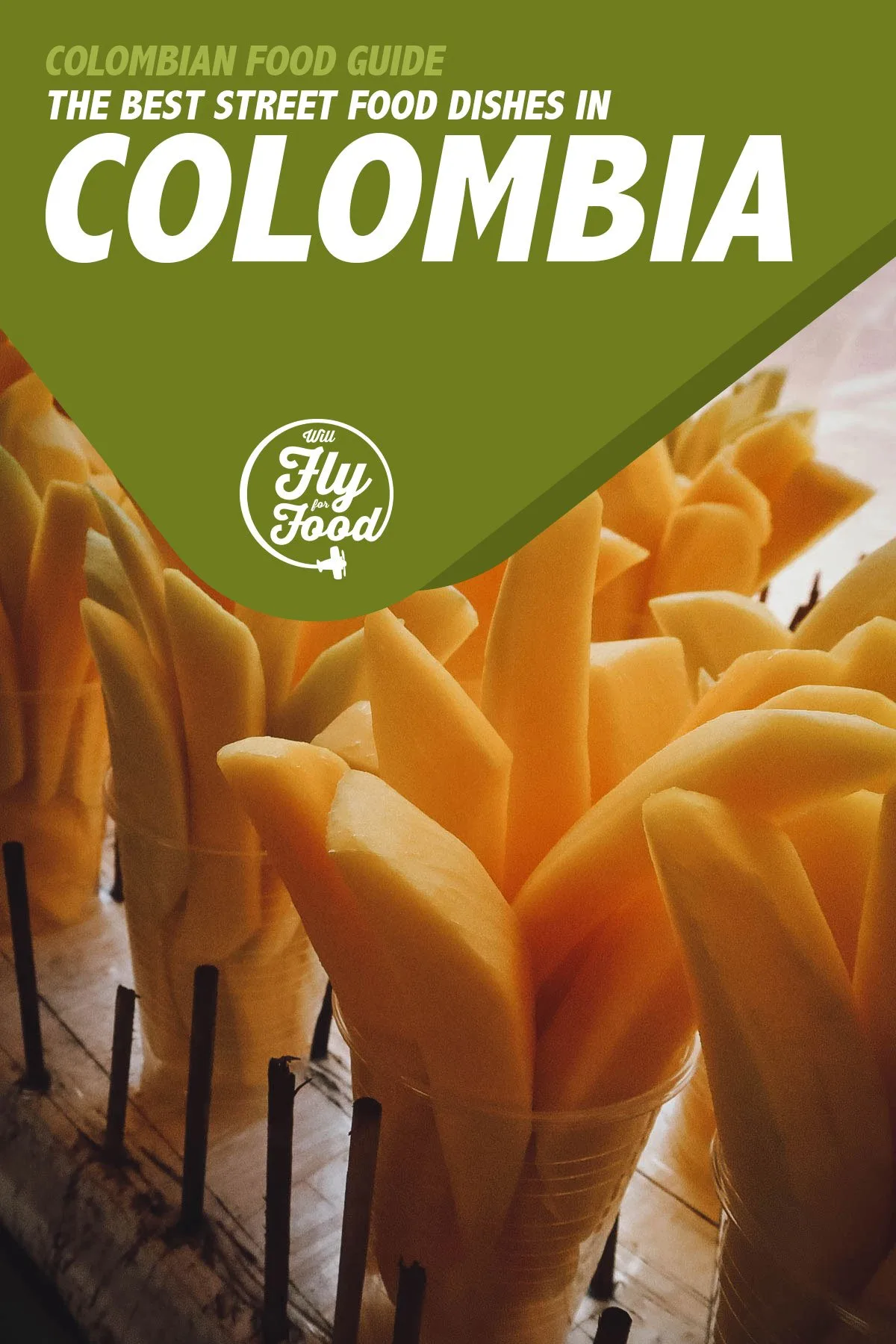
THE MOST DELICIOUS STREET FOODS IN COLOMBIA
1. Arepas
The arepa is perhaps the most important staple food in Colombian cuisine. Made with corn dough, it refers to a type of Colombian corn cake that’s eaten at practically every meal in Colombia. Order any traditional Colombian dish and chances are, it’ll be served with a side of arepas (among many other things).
Arepas are commonly eaten for breakfast, lunch, and dinner, but they’re also one of the most popular Colombian street foods. Here are two of my favorite versions:
Arepas de Huevo
When a Colombian college friend of mine saw that we were in Cartagena, the first thing she told me was: “You need to try arepa de huevo”. A quintessential street food in Cartagena, it’s a type of stuffed arepa that’s popular along the Caribbean coast of Colombia.
An arepa de huevo consists of a corn cake that’s been filled with ground meat and a raw egg and then deep-fried. It’s typically filled with both ground meat and egg, but you can get it with just egg as well. Just ask for an “arepa solo huevo” (pictured below).
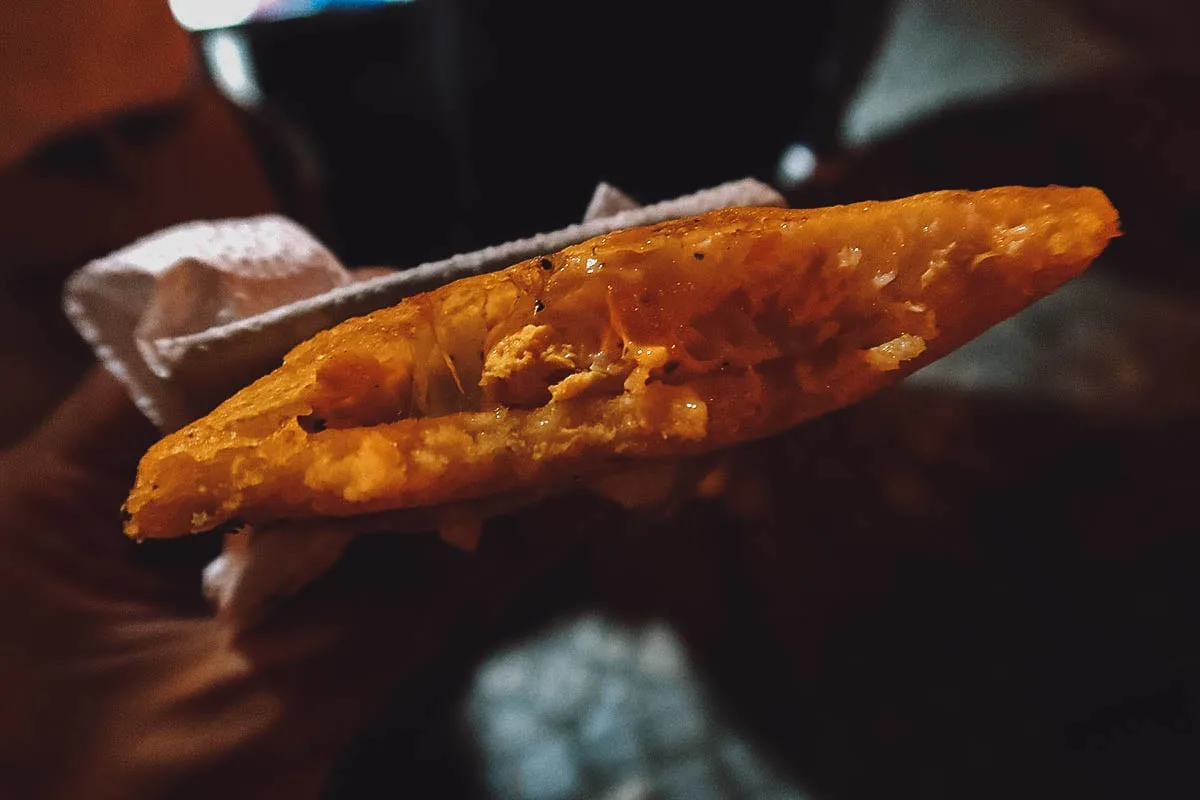
Here’s what it looks like when filled with both ground meat and a fried egg. Commonly sold at street stalls throughout Cartagena, this tasty parcel of meat and egg turned out to be one of my favorite Colombian street foods. Don’t miss it!
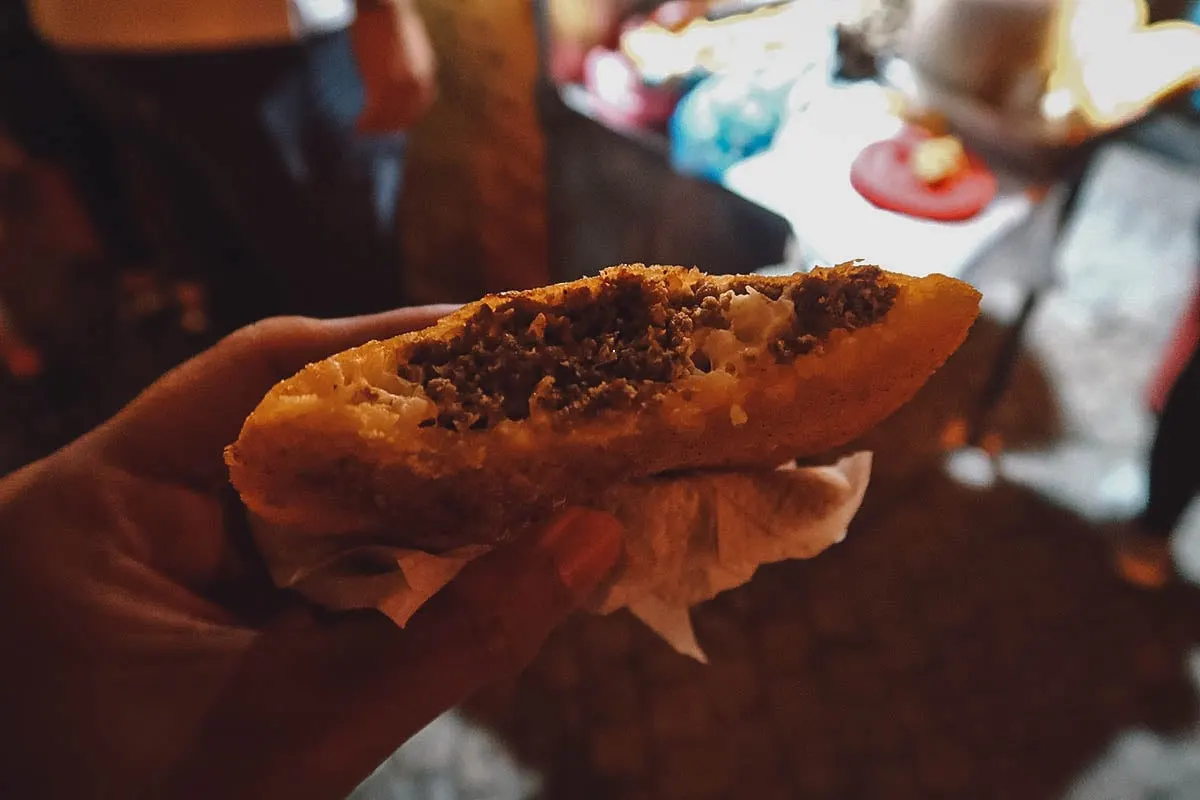
Arepas de Queso
Just as popular as arepas de huevo are arepas de queso, or arepas filled with cheese. They’re a popular street food or breakfast treat consisting of arepas filled with butter and queso costeño, a salty and soft Colombian white cheese. You can think of it as the Colombian version of a grilled cheese sandwich.
I didn’t try it but I’ve seen arepas de queso topped with sweetened condensed milk as well. I believe that version is more commonly eaten for breakfast.
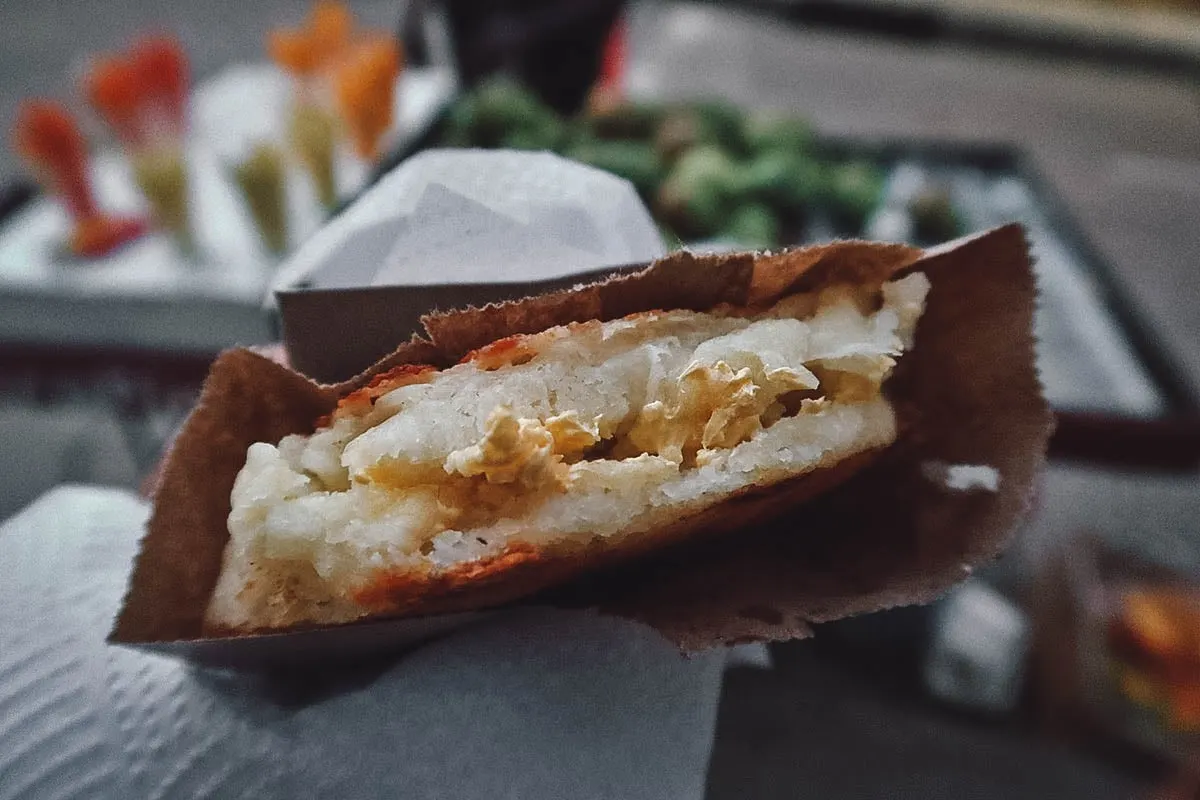
2. Empanadas
If you’ve been to any Spanish-speaking country, then chances are, you’ve had your fair share of empanadas.
Originally from Spain, this street food staple is commonly sold by street vendors in many countries throughout South America and Latin America like Venezuela, Argentina, Mexico, and Chile. Thanks to the Spanish influence, it’s become a popular snack in the Philippines as well.
Empanadas come in many forms but in Colombia, they’re typically made with corn flour and almost always deep-fried. They can be filled with a variety of different ingredients like ground meat, shredded chicken, potatoes, cheese, and vegetables.
A hugely popular snack, it doesn’t matter where you are in Colombia – just walk around any busy area and it won’t be long before you find a street vendor selling delicious, golden brown empanadas.
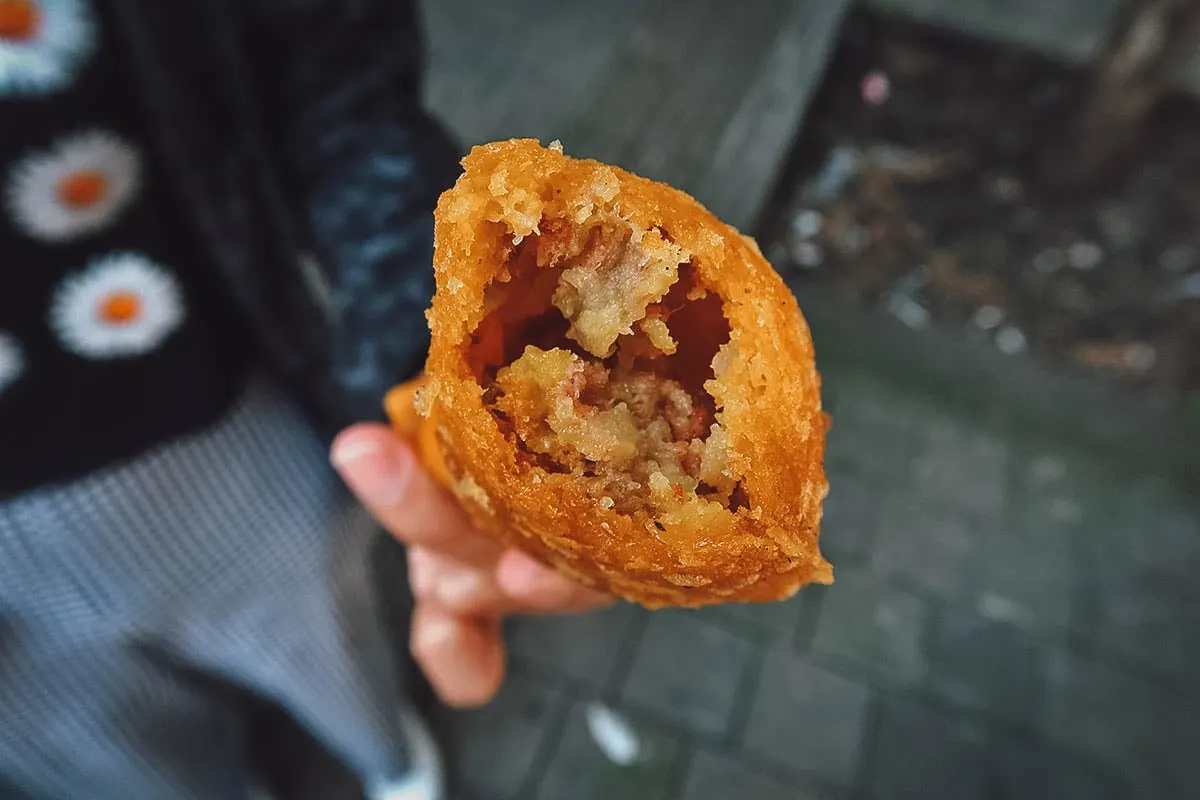
3. Carimañolas
Popular in Colombia and Panama, the carimañola is another delicious street food snack that you need to try in Colombia. It’s similar to an empanada except it’s torpedo-shaped and made with mashed yuca (cassava) instead of corn flour, giving it a softer texture.
Like empanadas, carimañolas can be filled with a variety of different ingredients, most commonly ground meat, shredded chicken, and cheese.
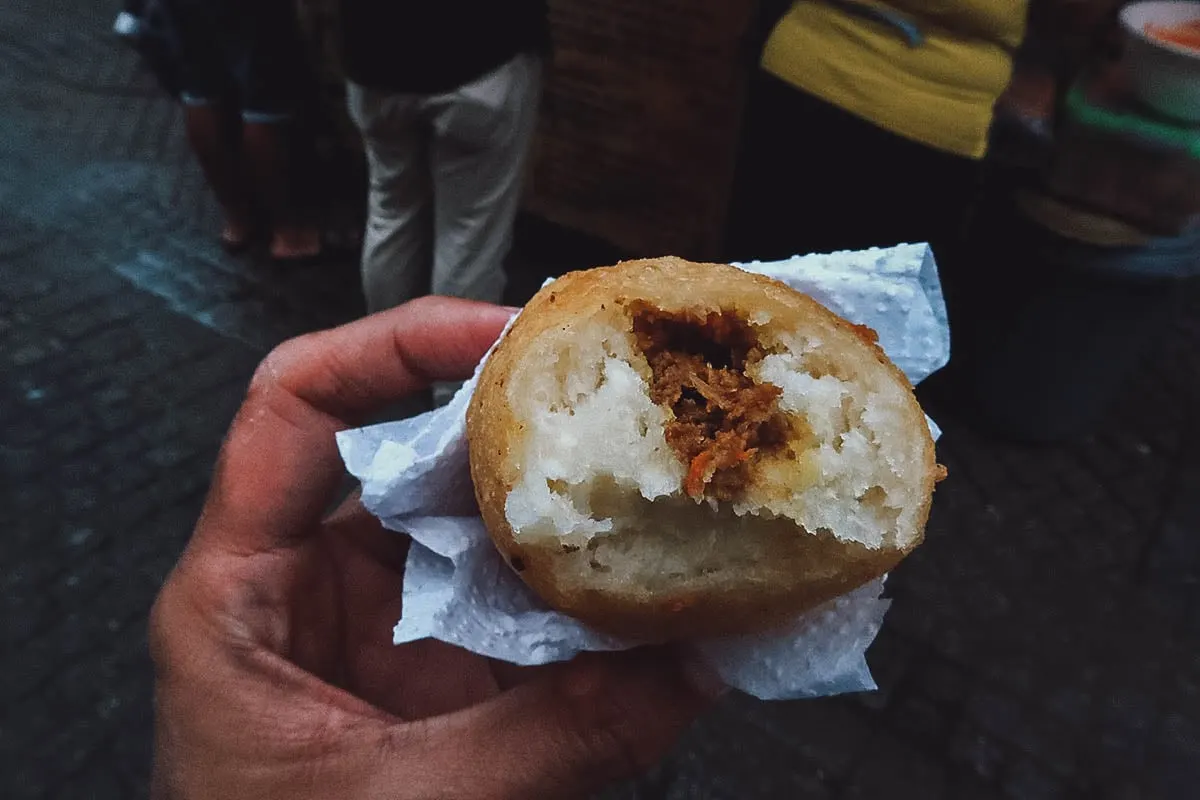
4. Papas con huevo y carne
If arepas de huevo were my favorite afternoon snack in Cartagena, then papas con huevo y carne may have been a close second. Many street vendors sell both so my tasty arepa de huevo was frequently followed by one of these chunky hot fried papas.
As you can probably guess from its name, papas con huevo y carne refer to deep-fried balls of mashed potatoes filled with eggs and spiced ground meat. (Are you starting to notice a pattern here?)
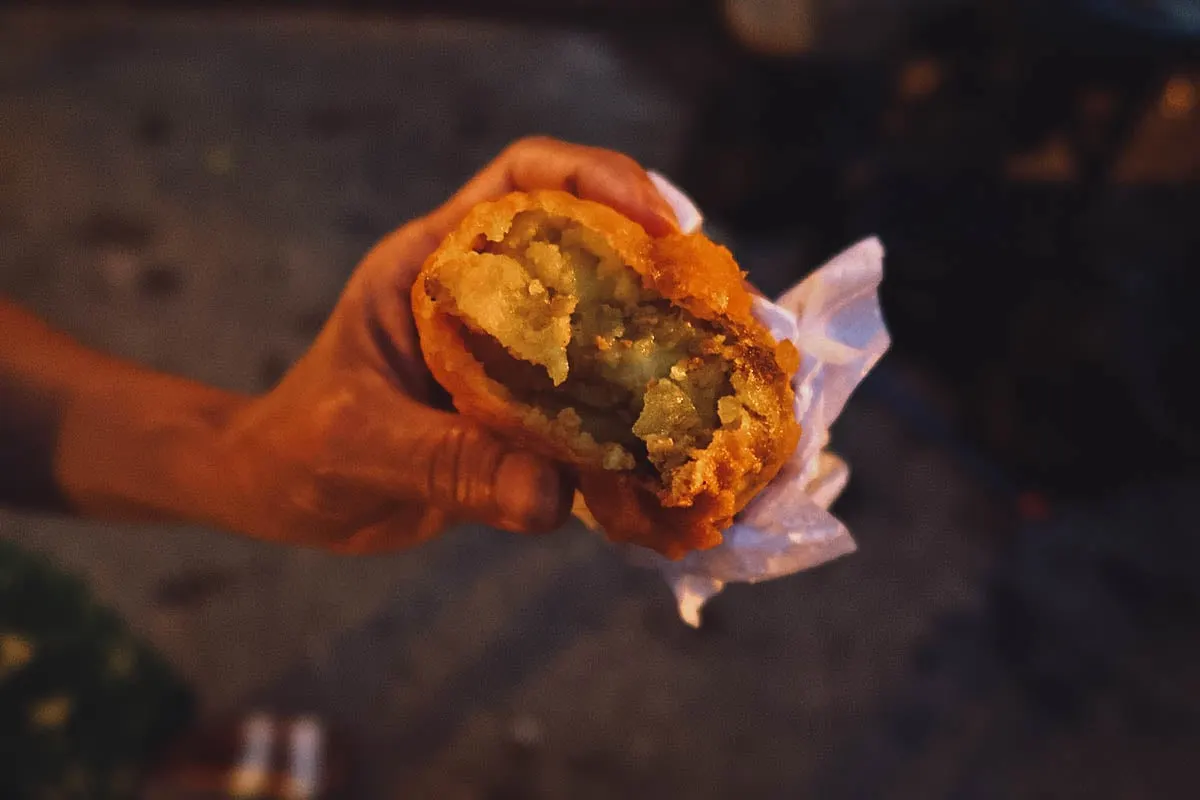
5. Tamales Tolimenses
Tamales are a staple dish in many countries throughout South America, Latin America, and the Philippines. In Colombia, one particularly delicious version hails from the Tolima Department in the Andean region of the country, hence the name tamal tolimense.
Tamales tolimenses are loaded with ingredients like chicken, pork ribs, potatoes, peas, carrots, boiled eggs, and rice. They’re commonly eaten for breakfast in Bogota, often with a cup of chocolate santafreño (hot chocolate with queso campesino).
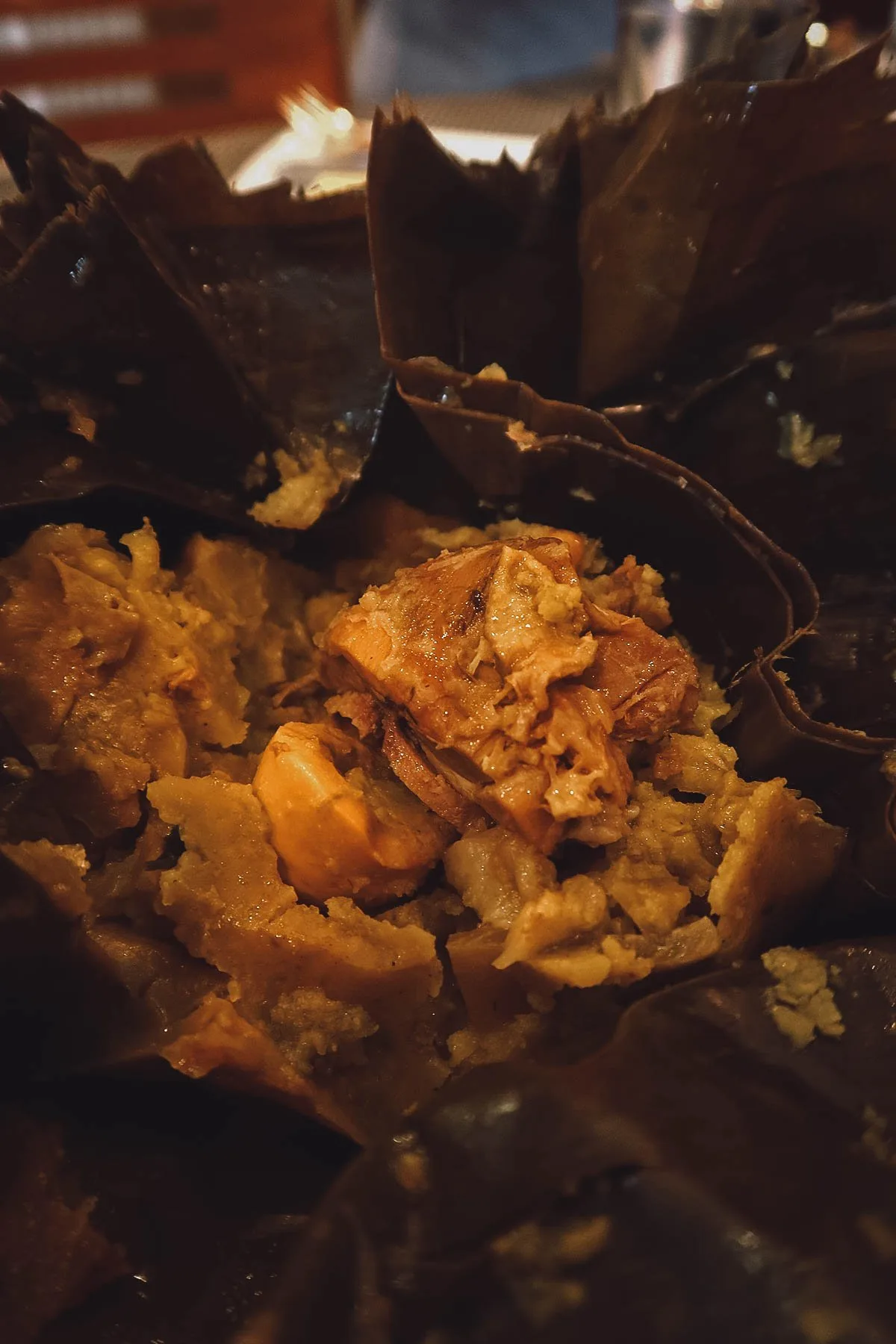
6. Bollo de Mazorca con Queso
If you like tamales, then you definitely need to try bollos de mazorca. They’re sweet corn rolls made with mashed or pureed corn that’s been wrapped in corn husks and then steamed. Unlike tamales which are made with nixtamalized corn, bollos de mazorca are made with fresh corn.
The version pictured below was served with cubes of white Colombian cheese, hence the name bollos de mazorca con queso.
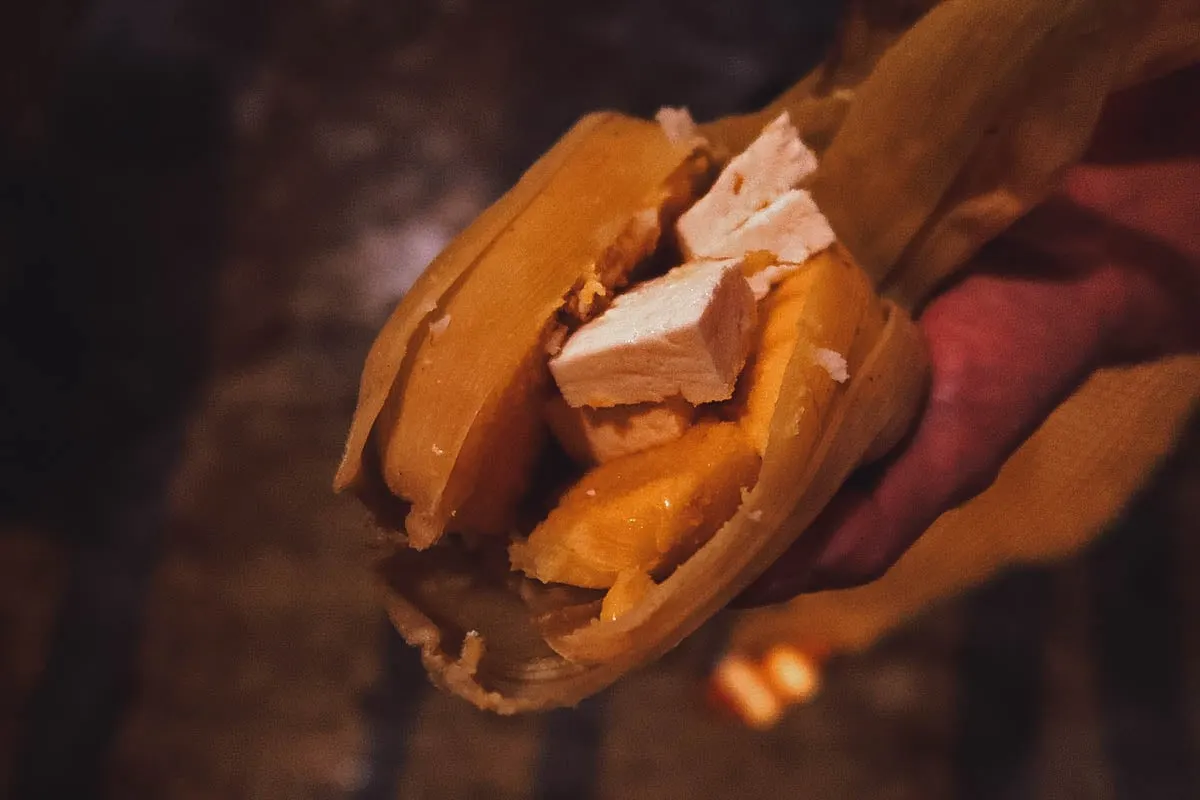
7. Colombian Cheese Bread
In Cartagena, I often started my day with cheese bread and a cup of Colombian coffee. Visit a traditional bakery in any Colombian city and you’ll find different types of cheese bread. These are three of the most common.
Almojábana
The almojábana is perhaps the most well-known type of Colombian cheese bread. It’s made with cornmeal and cuajada cheese, a type of fresh cheese made with non-pasteurized milk.
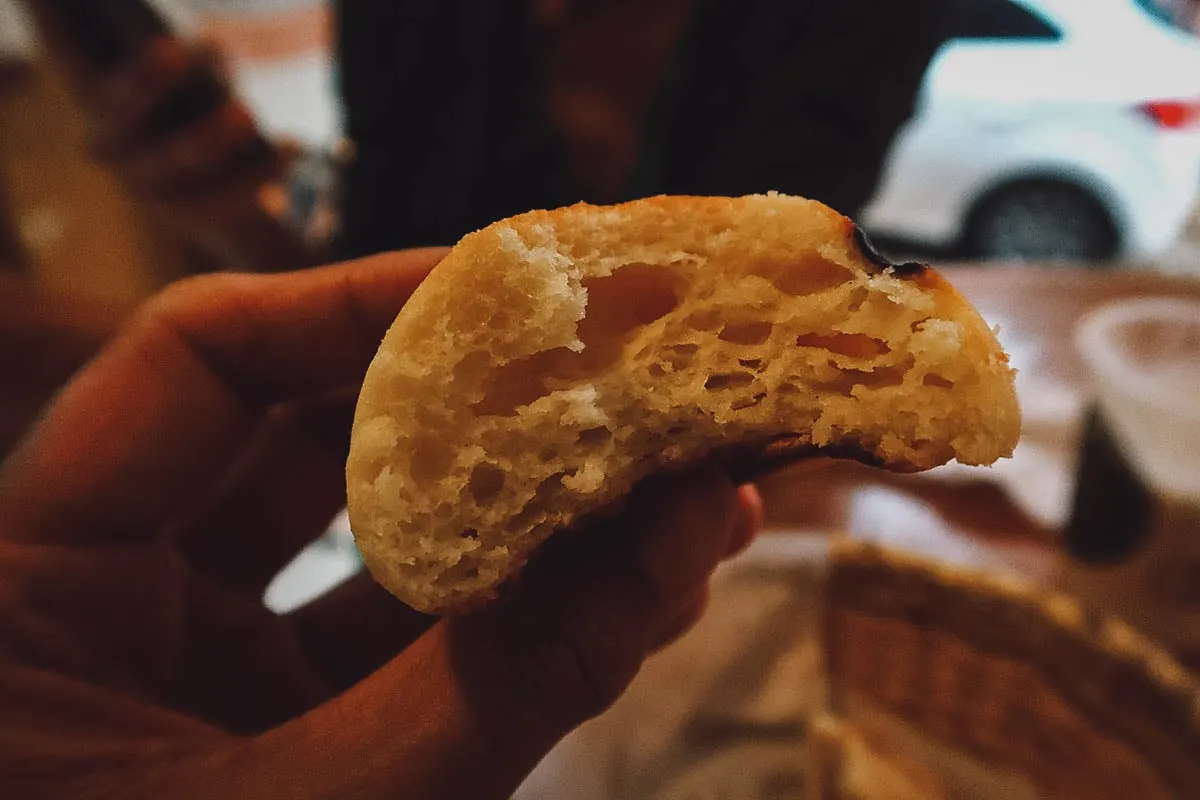
Pandebono
Pandebono is similar to almojábana except it’s made with yuca flour, corn flour, and costeño cheese. Between the two, I actually prefer pandebono thanks to its springier texture from the yuca flour.
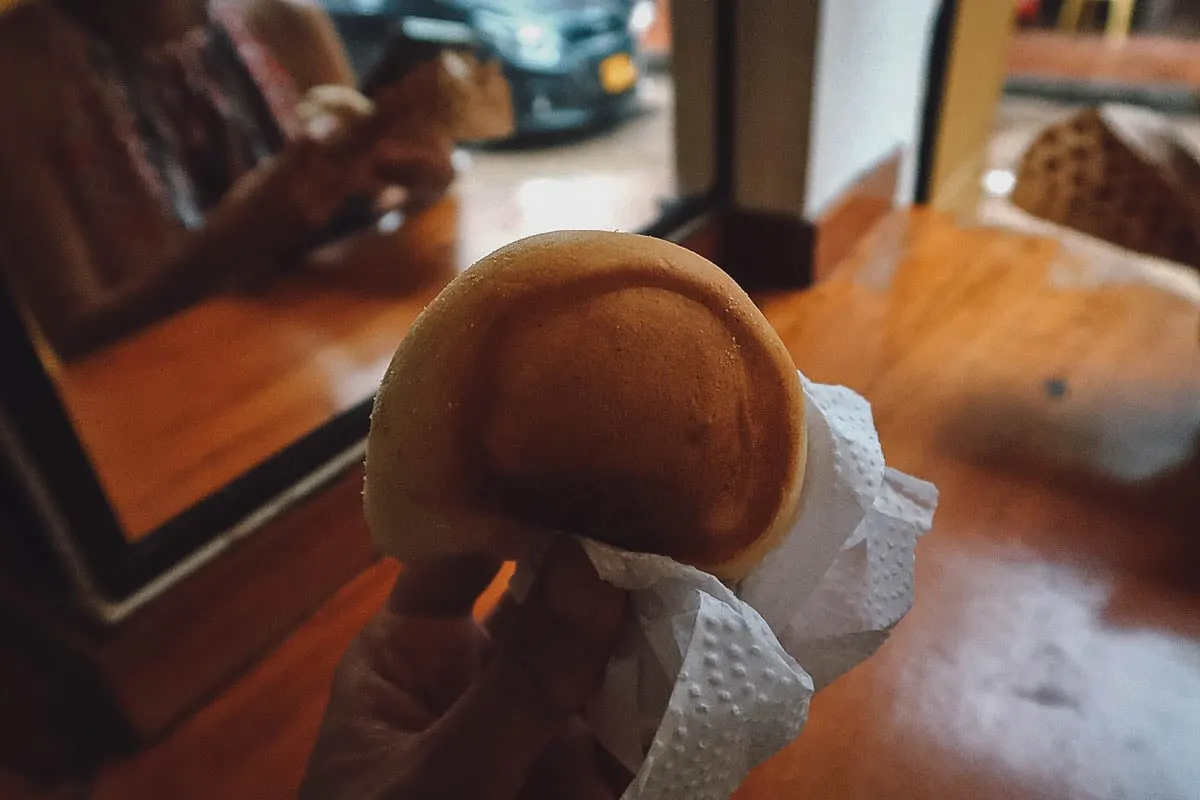
Pandeyuca
Ignoring the irregular shape, pandebono and pandeyuca are actually quite similar except the latter is made purely with yuca flour. This small difference yields a bread roll that’s much airier and drier than pandebono.
Of the three, I find pandeyuca to be the most interesting. You can’t tell from this picture but it’s almost completely hollow inside.
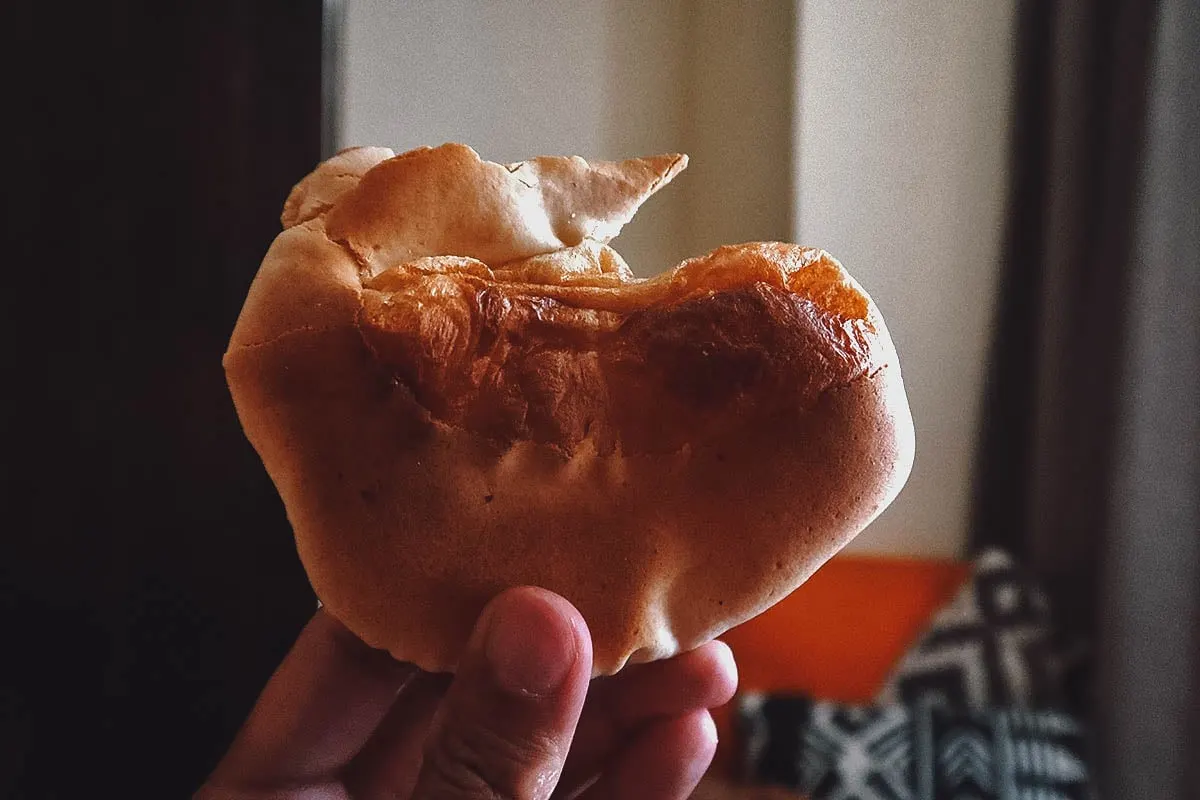
8. Buñuelos
The buñuelo is another Spanish street food snack that can be found in different forms throughout Latin America. Depending on where they’re from, they can be flat, round, ring-like, or even rosette-shaped.
In Colombia, buñuelos usually take the shape of a small ball or oval made with corn starch and yuca flour. They’re typically made with curd white cheese and deep-fried, though they can be filled with other ingredients as well like guava jam, arequipe (dulce de leche), and chocolate.
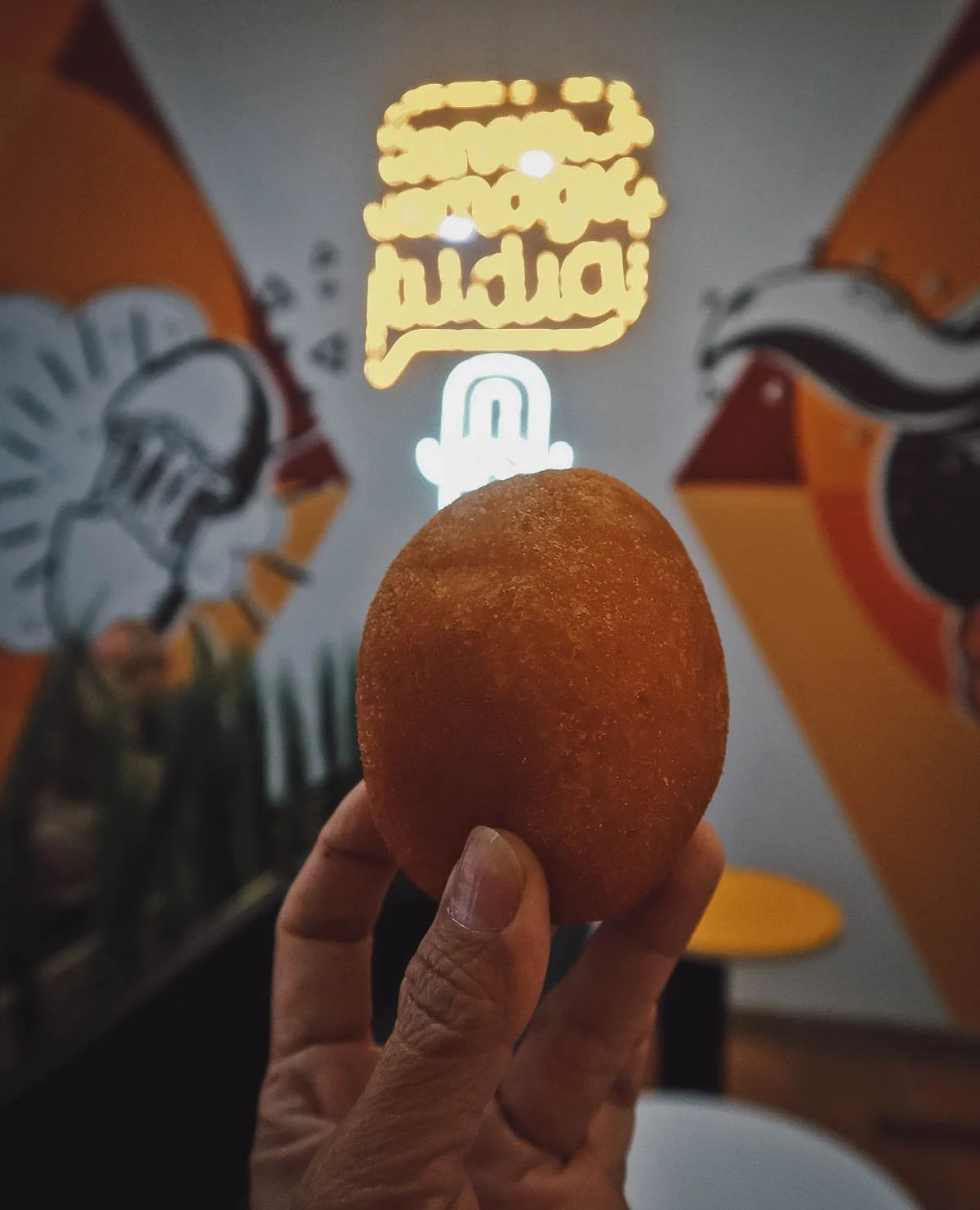
9. Dedo de Queso
Dedos de queso are among the most common Colombian street foods. It’s basically a Colombian cheese stick made with local white cheese. Dedo in Spanish means “finger”.
Dedos de queso are a common sight at street food stalls throughout Colombia. They can be made in different sizes. The one pictured below is fairly large but much smaller versions called deditos de queso (little fingers) are common as well.
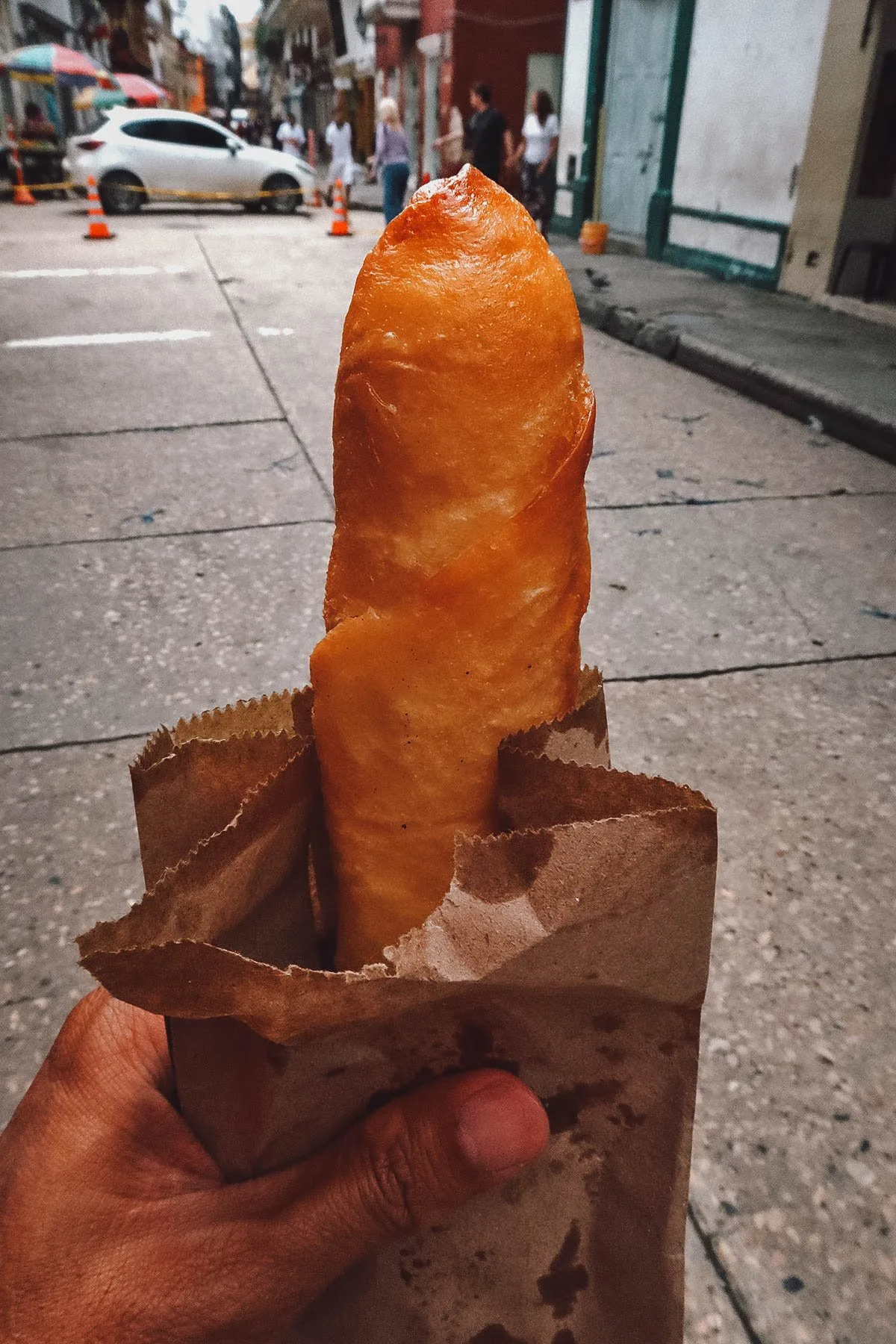
10. Pinchos / Chuzos
Meat on a stick? Yes, please!
Pinchos or chuzos refer to Colombian meat skewers. Grilled over hot charcoal, they’re a popular street food and can be made with different types of meat like chicken, beef, pork, or sausages.
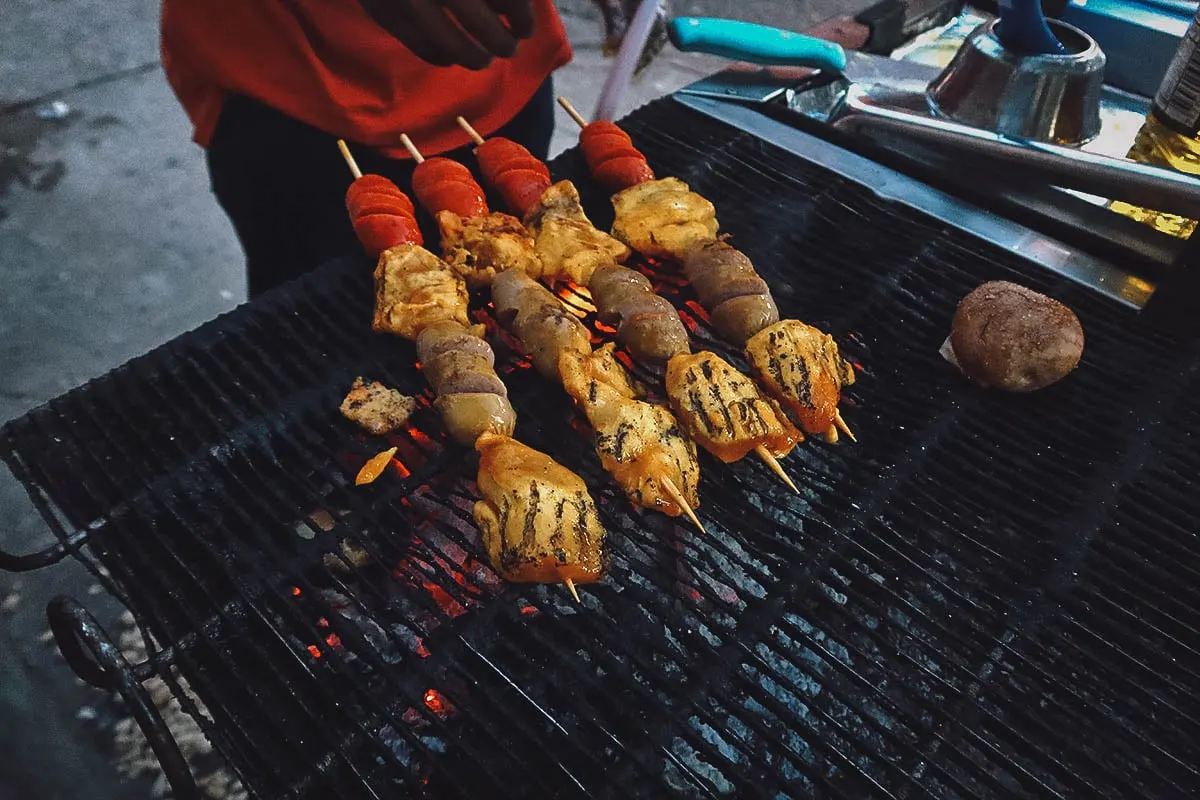
Behold this big pincho from a street vendor in Cartagena! He poured two sauces over the meats and stuck a hot potato at the end before serving.
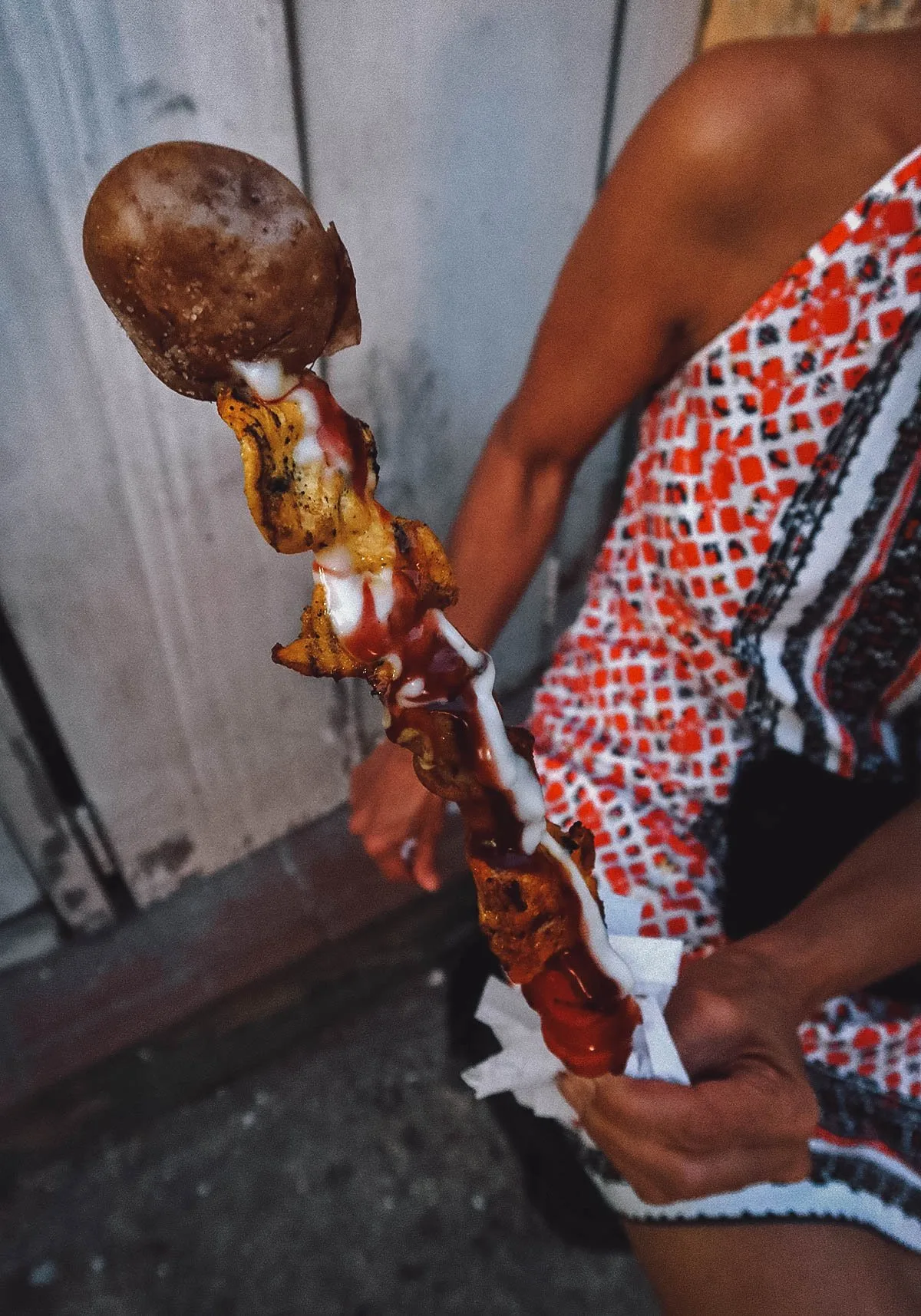
11. Salchipapas
Salchipapa is a portmanteau word for salchicha (sausage) and papa (potato) – the two main ingredients in this popular street food dish. It’s originally from the streets of Lima, Peru, though it’s become popular in other parts of South America as well like Colombia, Bolivia, Argentina, and Ecuador.
As its name suggests, salchipapa is made with sausages and french fries but it can contain many other ingredients as well. This overflowing bowl from a food hall in Medellin was topped with bacon, quail eggs, shredded cheese, cheese sauce, and barbecue sauce. Satisfying and seriously yummy.
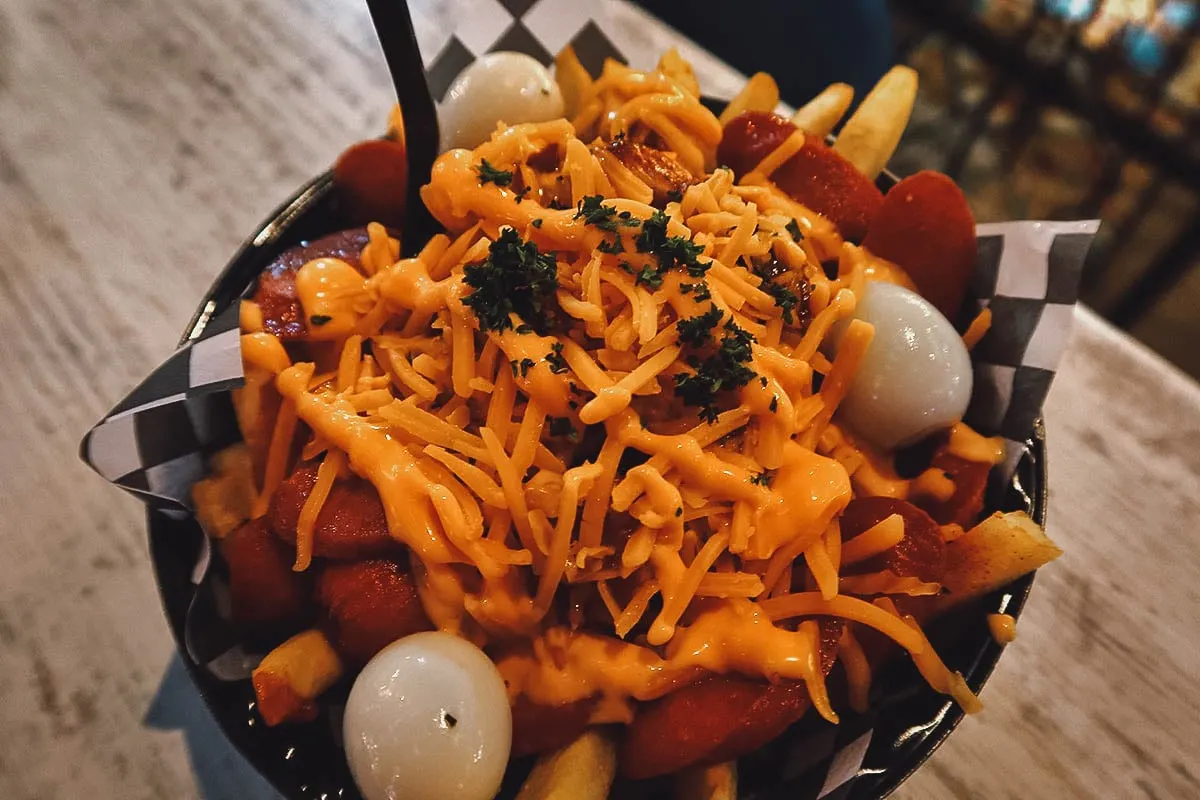
12. Lechona Tolimense
If you’ve enjoyed roast pig in Spain, Latin America, or the Philippines, then the word lechon will already be familiar to you. It refers to a popular festival dish consumed in Spain and many of its former colonies.
In Colombia, it’s referred to as lechona tolimense. Largely associated with Tolima Department, it consists of a slab of pork fatback that’s been stuffed with chunks of pork, rice, peas, and spices. The stuffed pork is then baked in an oven for up to twelve hours until the skin becomes crackingly crisp.
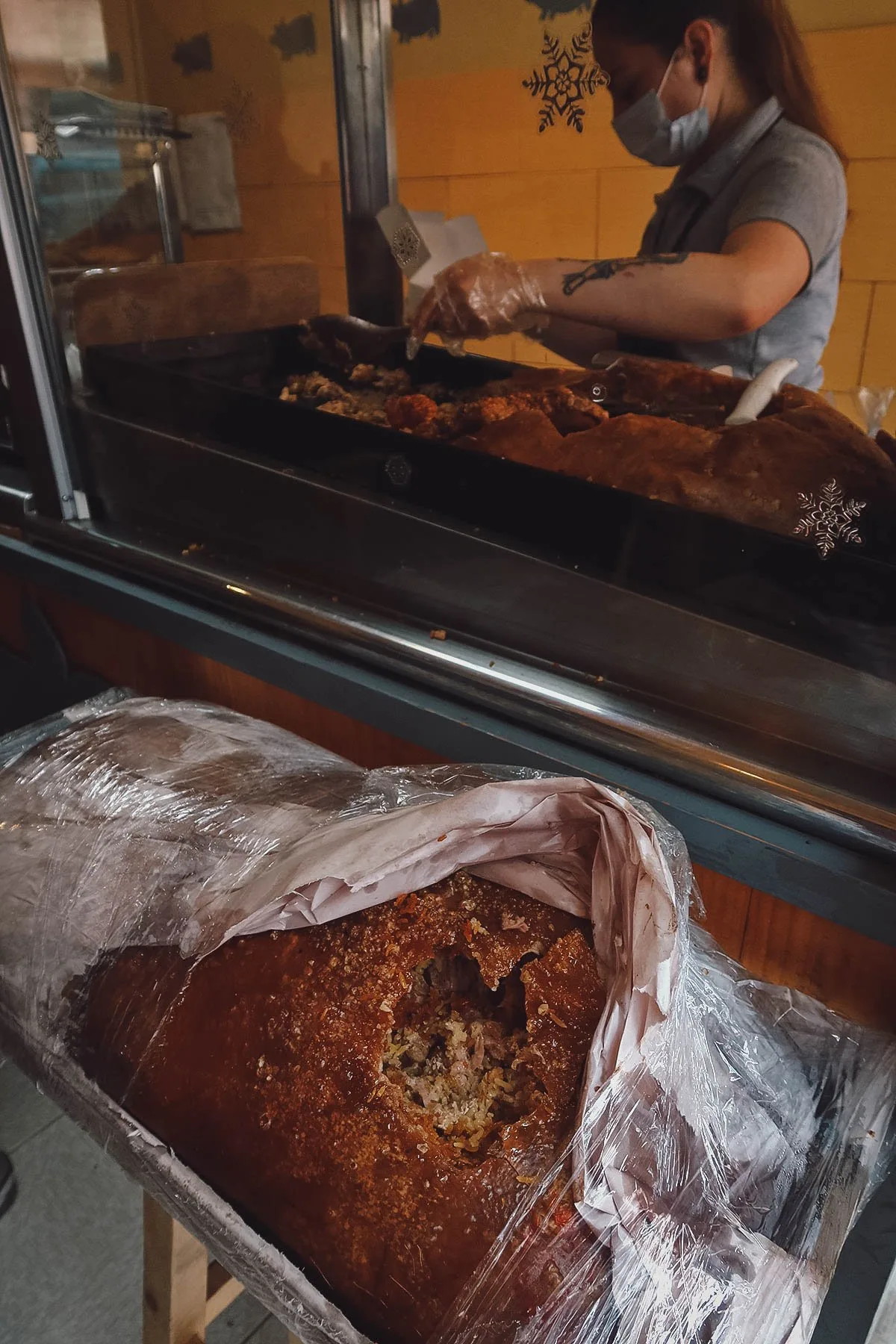
We went on a food tour in Bogota and one of the stops was a hole-in-the-wall that served nothing but lechona. Being from the Philippines, I know lechon well and I can say that this Colombian version is delicious, especially when paired with some vinegar.
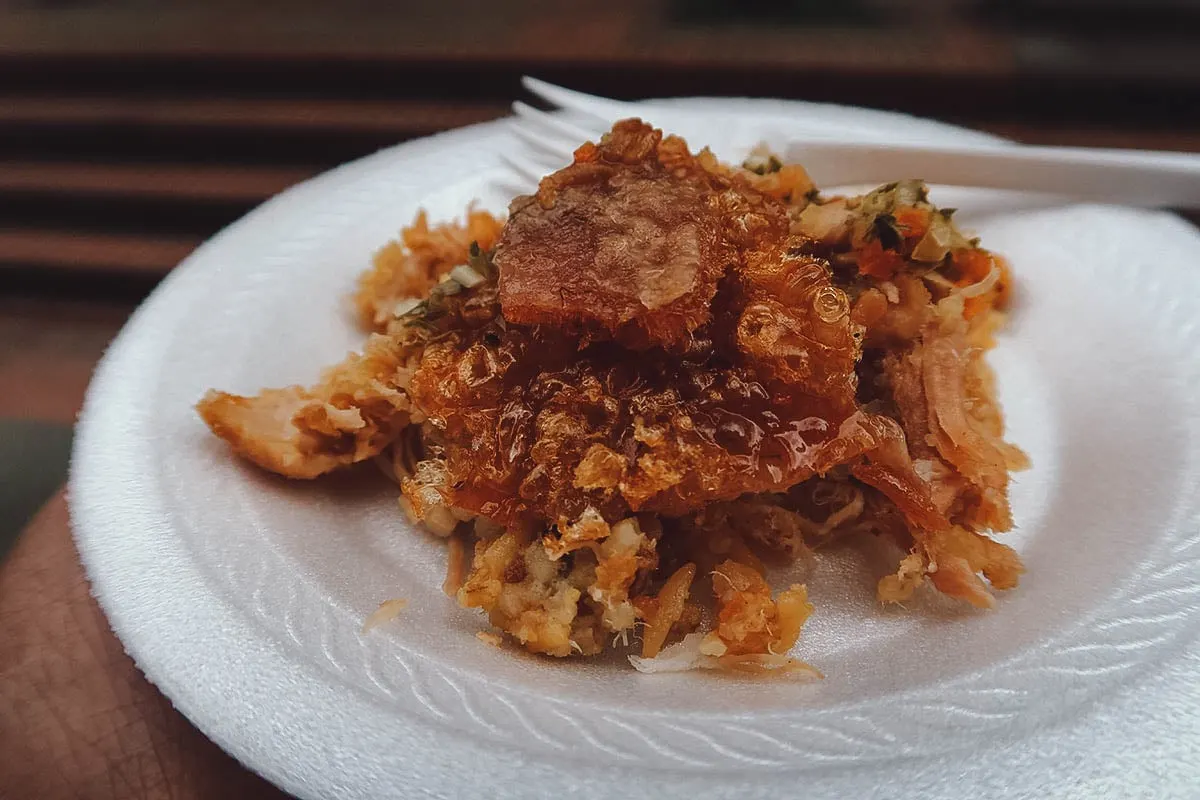
13. Cocteles
This Colombian street food dish called cocteles really surprised me. It surprised me because I didn’t expect it to be as good as it was. It’s frikking delicious.
Cocteles are made with different types of seafood dressed in a cocktail sauce consisting of ketchup, hot sauce, mayonnaise, lime juice, onions, and cilantro. Coctel de camarones (shrimp) is the most common but it’s often made with crab, octopus, squid, clams, and sea snails as well.
A popular street food in Cartagena, cocteles are served in styrofoam cups with saltine crackers. They’re surprisingly tasty and easily one of my favorite Colombian street foods.
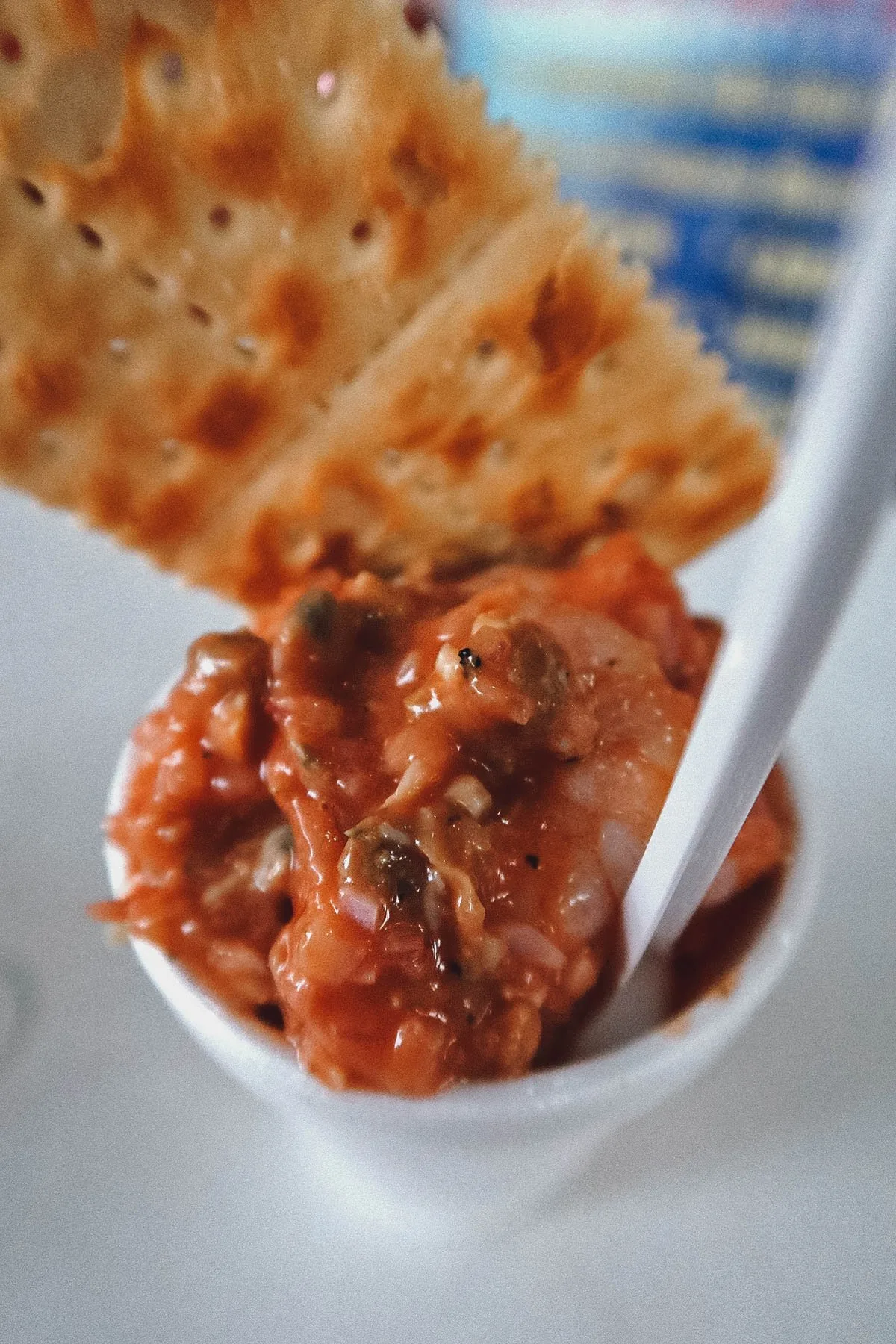
14. Patacones
Like arepas, patacones are among the most common side dishes in Colombian cuisine. They’re flattened discs of double-fried unripe plantains that are often served alongside larger Colombian meals. And like arepas, it’s also common to see them sold as street food.
Pictured below is a patacon topped with chicharron (fried pork belly) and a block of white cheese. This was filling enough, but if you’re really hungry, then you can order a patacon con todo. As its name suggests, it’s topped with a whole mess of ingredients like shoestring potatoes, sausages, chicharron, shredded chicken, cheese, and a fried egg.
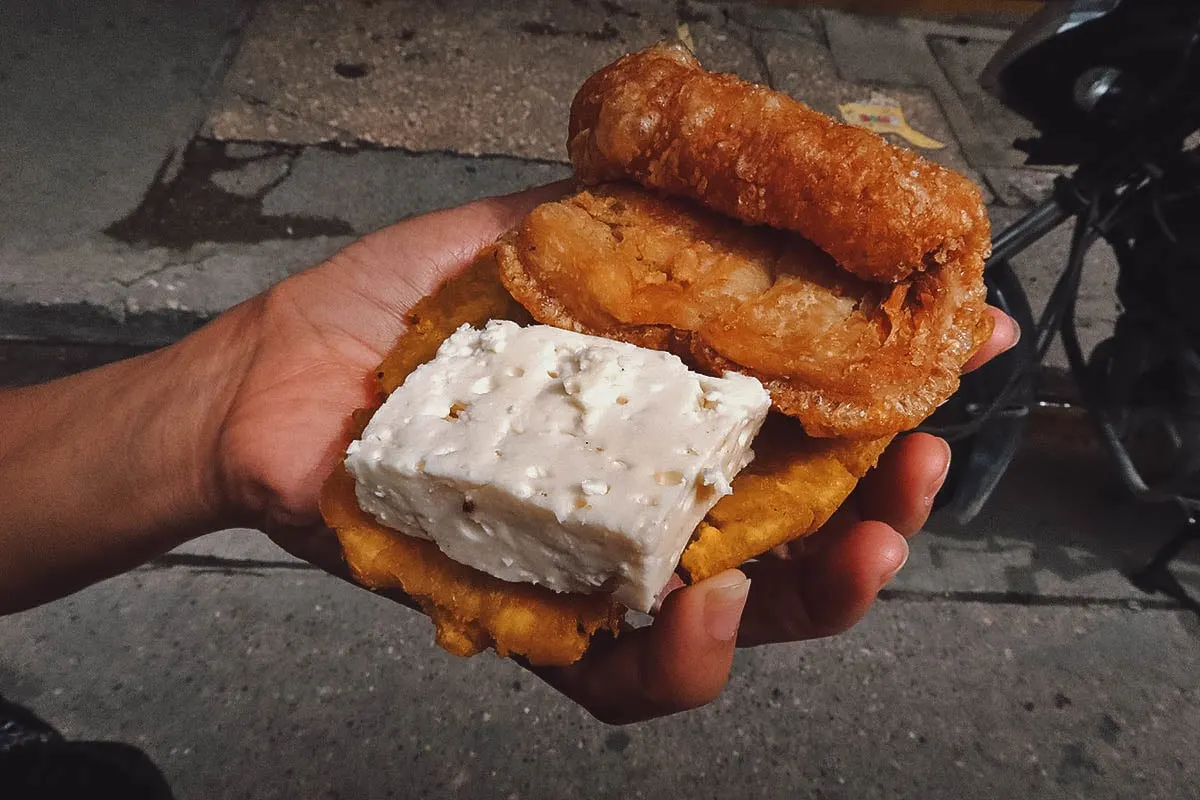
15. Hormigas Culonas
This next Colombian street food is reserved for the more daring. Hormigas culonas literally means “big-assed ants”. It’s the perfect way of describing this species of large leaf-cutter ant (Atta laevigata) that’s been consumed by the Guane indigenous people of Santander Department for hundreds of years.
Hormigas culonas are harvested for about nine weeks during the rainy season. Based on what I’ve read, only the queens are harvested, presumably because only they have the large abdomens which make them suitable for consumption.
Not surprisingly, these large-bottomed ants are viewed as aphrodisiacs and have been traditionally given as wedding gifts.
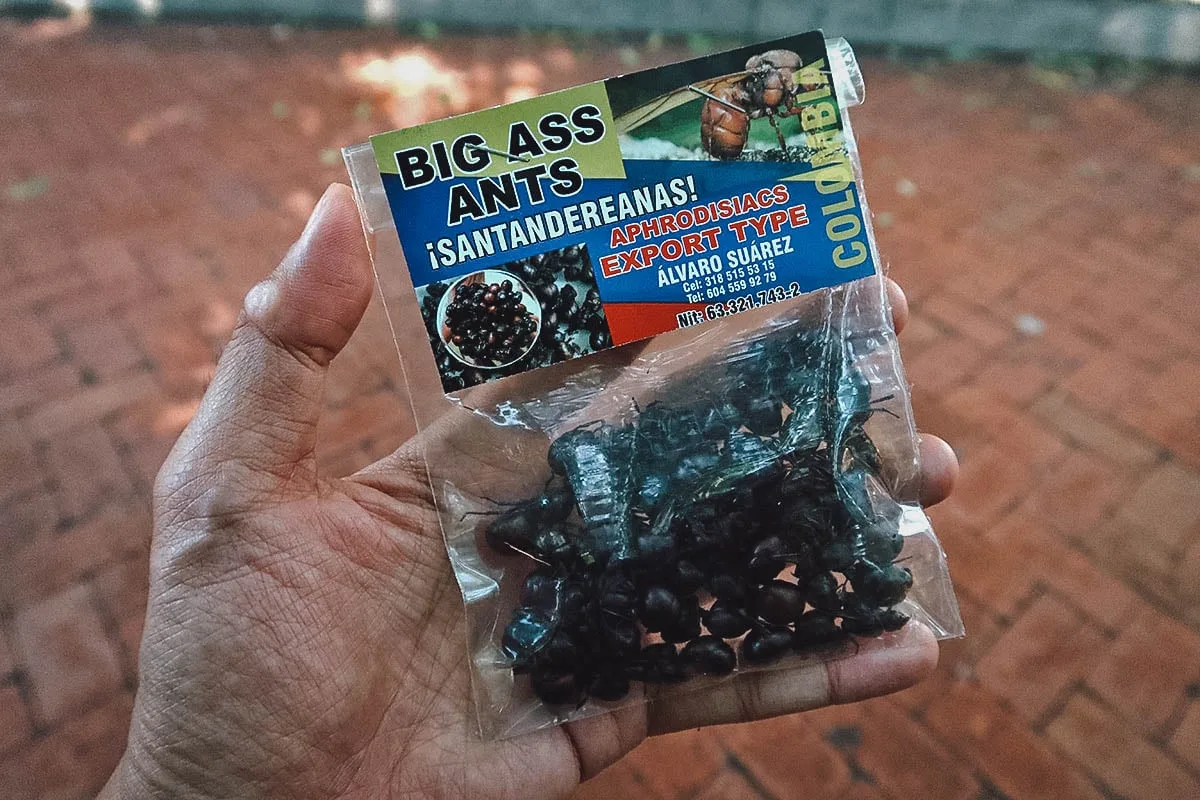
These ants are huge! At first glance, they look too big to be ants.
Hormigas culonas can either be toasted or fried. I don’t remember which one we got but one was more expensive than the other. I think we may have gotten the toasted version.
Like cocteles, I was surprised by how good these ants were. I was expecting them to be tasteless but they were anything but. Hormigas culonas are shockingly tasty. They’re crunchy, nutty, almost chocolatey. They’re said to be highly nutritious too and make for a great snack with cold beer. Very addictive!
If you aren’t squeamish with your food choices, then I highly recommend picking up a pack of hormigas culonas. It’s definitely one of the more unique street foods you’ll find in Colombia.
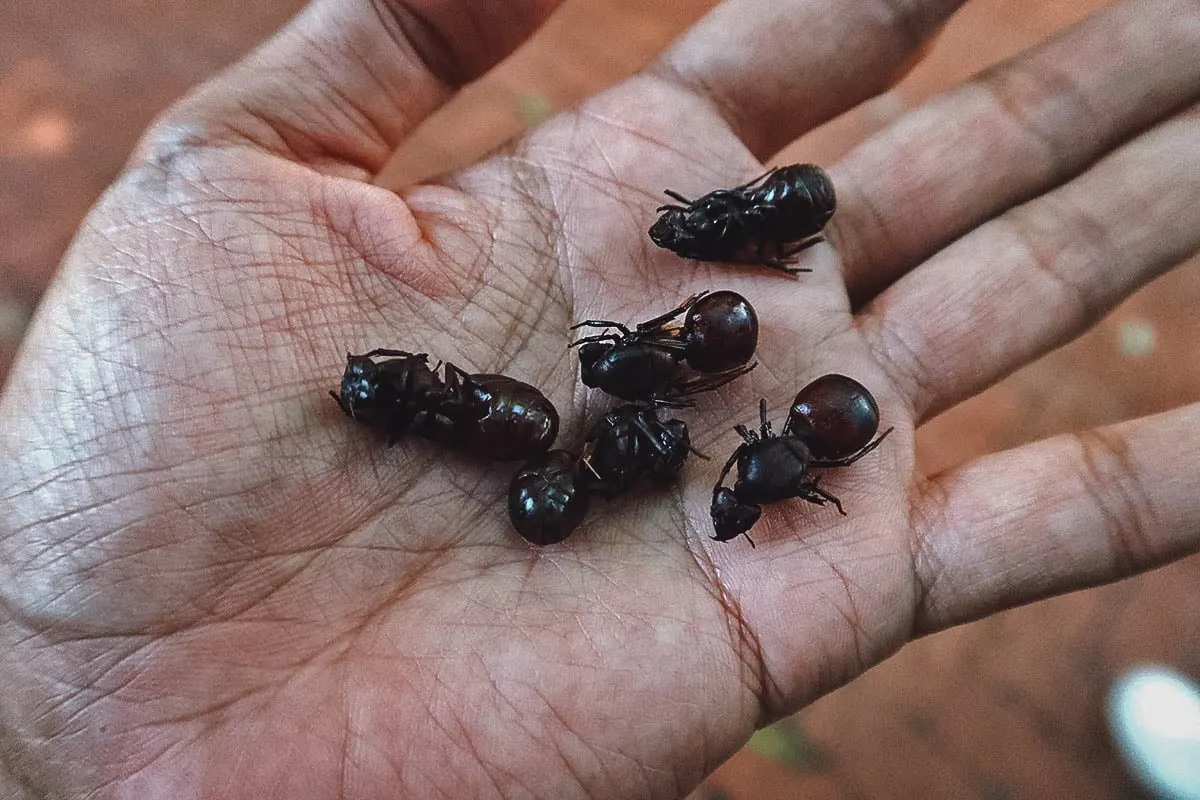
16. Perros Calientes
There are hot dogs, and then there are Colombian hot dogs. Called perros calientes (literally, “hot dogs”), these local versions are among the most beloved Colombian street foods in Medellin, and probably unlike any hot dog you’ve ever seen.
What makes perros calientes different from their American counterparts are the toppings. Instead of the standard ketchup, mustard, and pickle relish, perros calientes are topped with a boatload of less conventional ingredients like ceviche, crab, shrimp in coconut sauce, refried beans, arugula, crushed potato chips, and shoestring potatoes.
After a night of partying in Medellin, nothing can satisfy your drunken cravings more than a perro caliente.
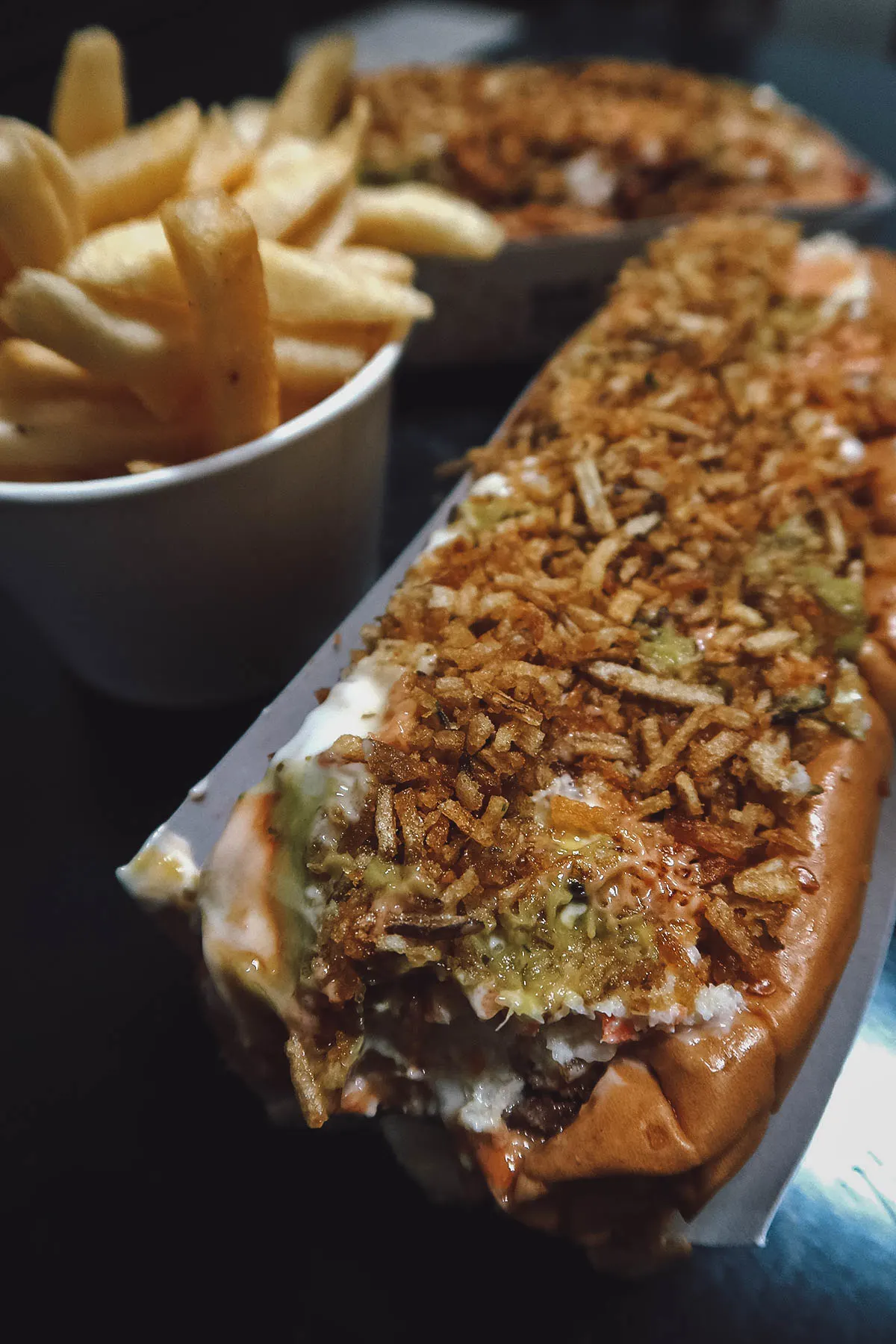
17. Mango Biche
There’s no shortage of tropical fruits in Colombia. Walk around the streets of Cartagena or Medellin and you’ll find lots of vendors selling fresh fruits like passion fruit, lulo, guava, and soursop. On our Bogota food tour, we even got to try some really exotic fruits that I unfortunately don’t remember the names of!
Some street vendors can turn them into fresh fruit juice but I prefer eating them sliced into chunks. My favorite is definitely mango biche. A popular street food in Cartagena, it refers to slivers of fresh green mango dressed with lime juice and salt.
If you like all things sweet and sour, then you’ll surely enjoy mango biche.
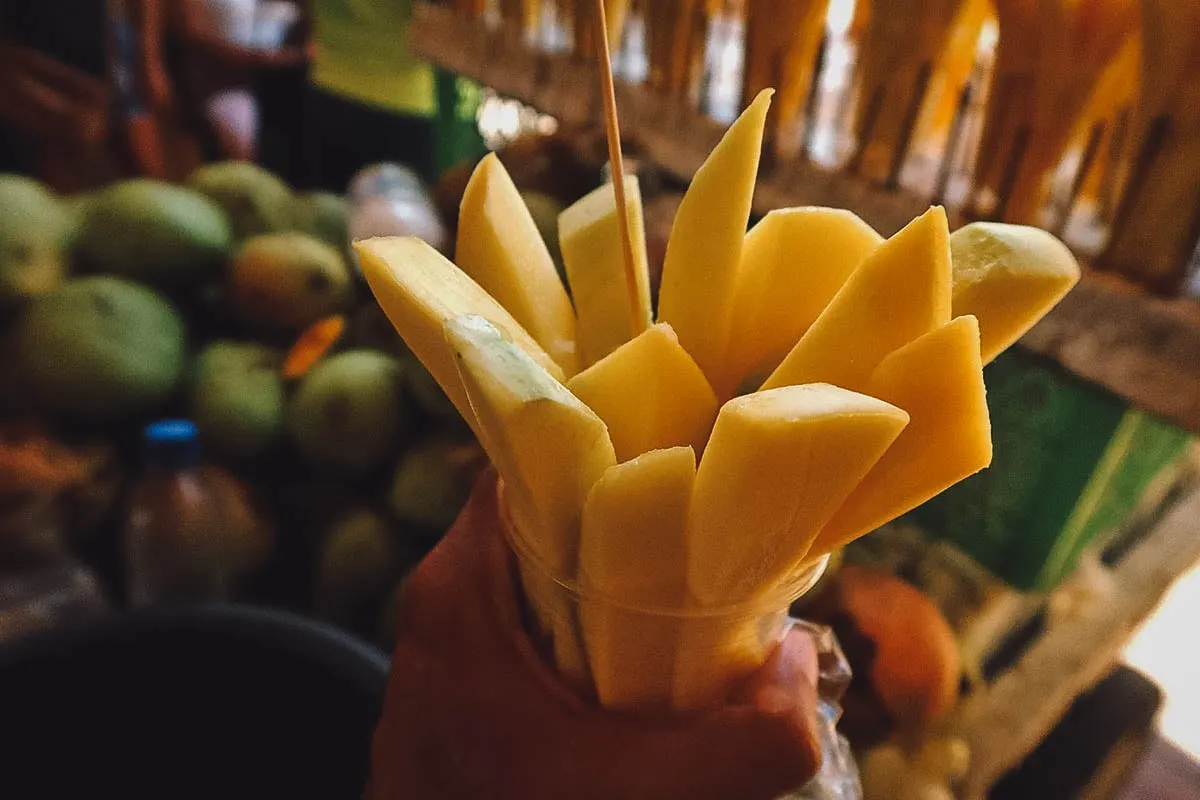
18. Cocada
This traditional candy made with shredded coconut and sugar was one of my favorite street foods in Colombia. It exists in many variations and flavors not just in Colombia, but throughout Central and South America. We even have something very similar in our native Philippines called bukayo.
Of all the cities we visited in Colombia, cocada was most popular in Cartagena. You’ll find a row of street vendors at Plaza de los Coches selling different types of dulces tipicos (typical sweets), one of the most popular being cocada.
I bought one at least once a day everyday while we were there and it brought me back to my childhood every time.
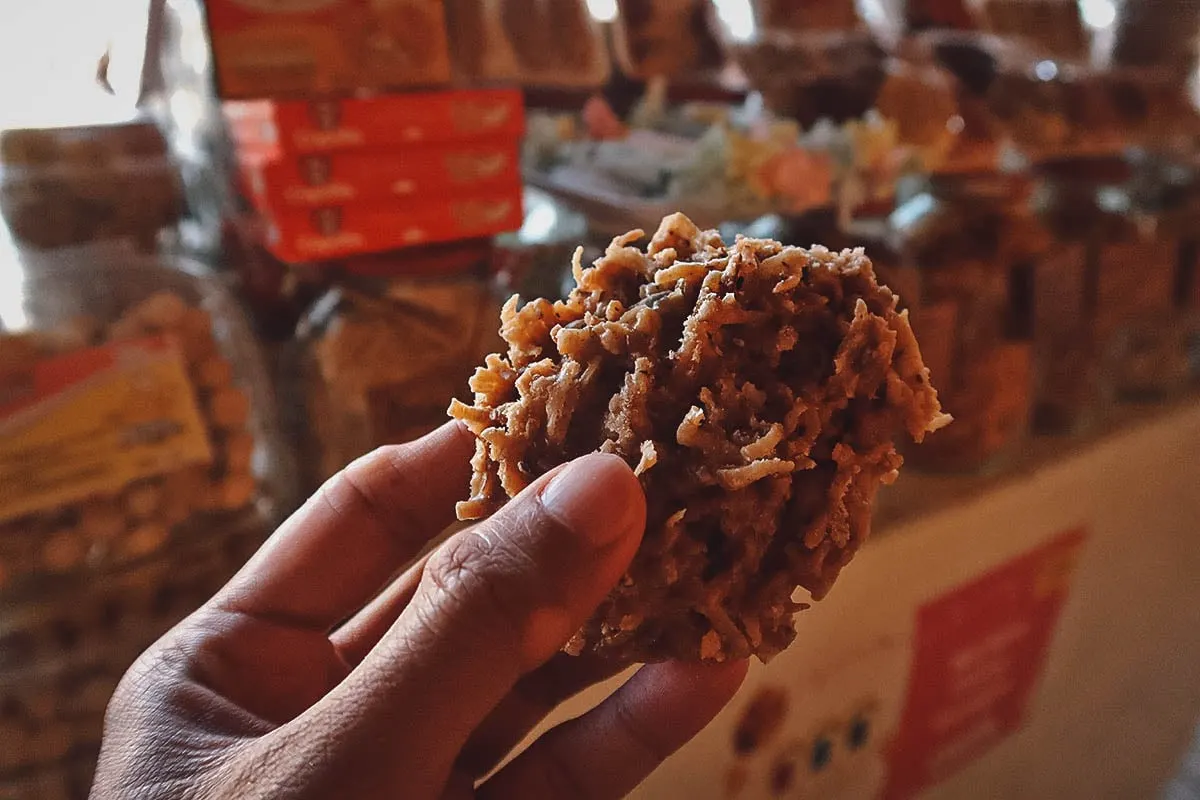
19. Bocadillo
If cocada were my favorite Colombian candy, then bocadillo would be a close second. Consumed in many Latin American countries like Colombia, Venezuela, Costa Rica, and Panama, it’s made with guava pulp and panela (unrefined cane sugar) that’s been condensed into a bite-sized snack.
In Colombia, bocadillo is often paired with salty white cheese. The version pictured below has been combined with arequipe to make a delicious and highly addictive Colombian treat.
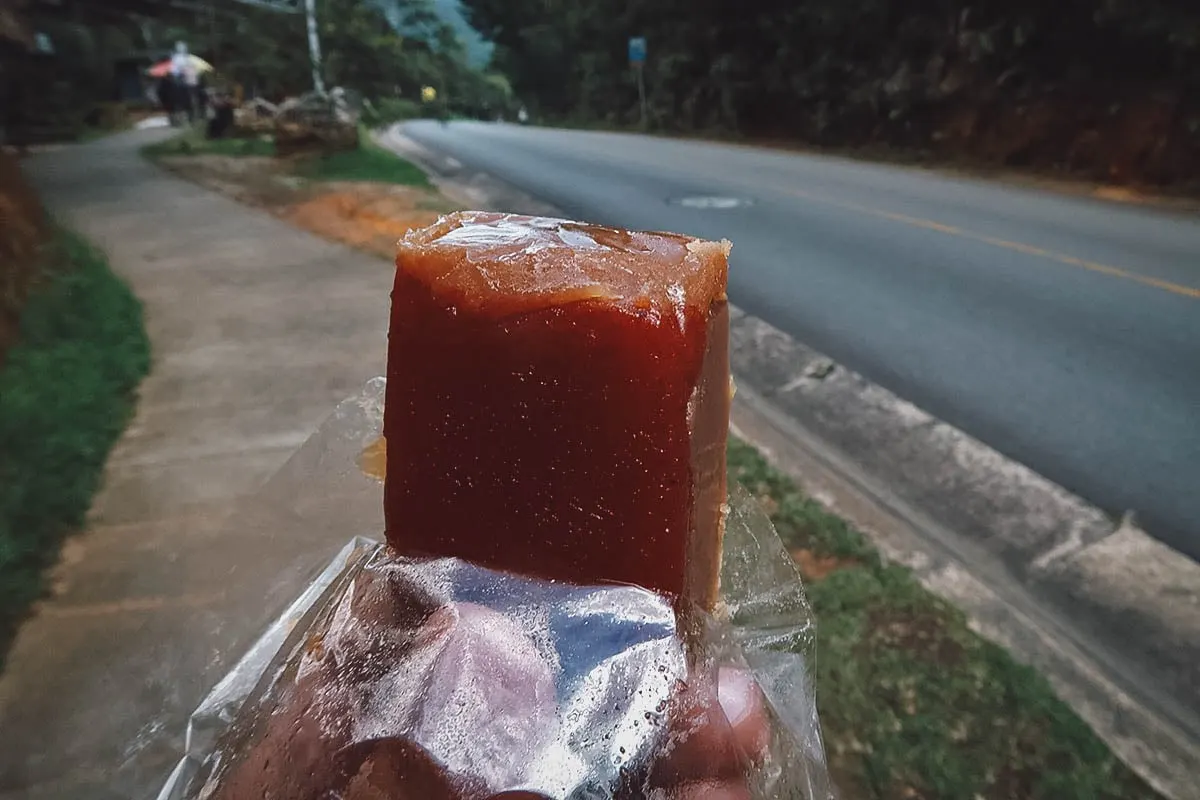
20. Brevas con Arequipe
Interesting dishes like brevas con arequipe are precisely why we enjoy going on food tours – you learn about obscure local dishes and drinks that you wouldn’t have known about otherwise.
Brevas con arequipe is a traditional Colombian snack consisting of cooked figs stuffed with dulce de leche. It’s an interesting combination of sweet, creamy, fruity, and (slightly) bitter that we couldn’t get enough of.
Brevas con arequipe was just one of the many delicious street food snacks that we learned about on our Bogota food tour.
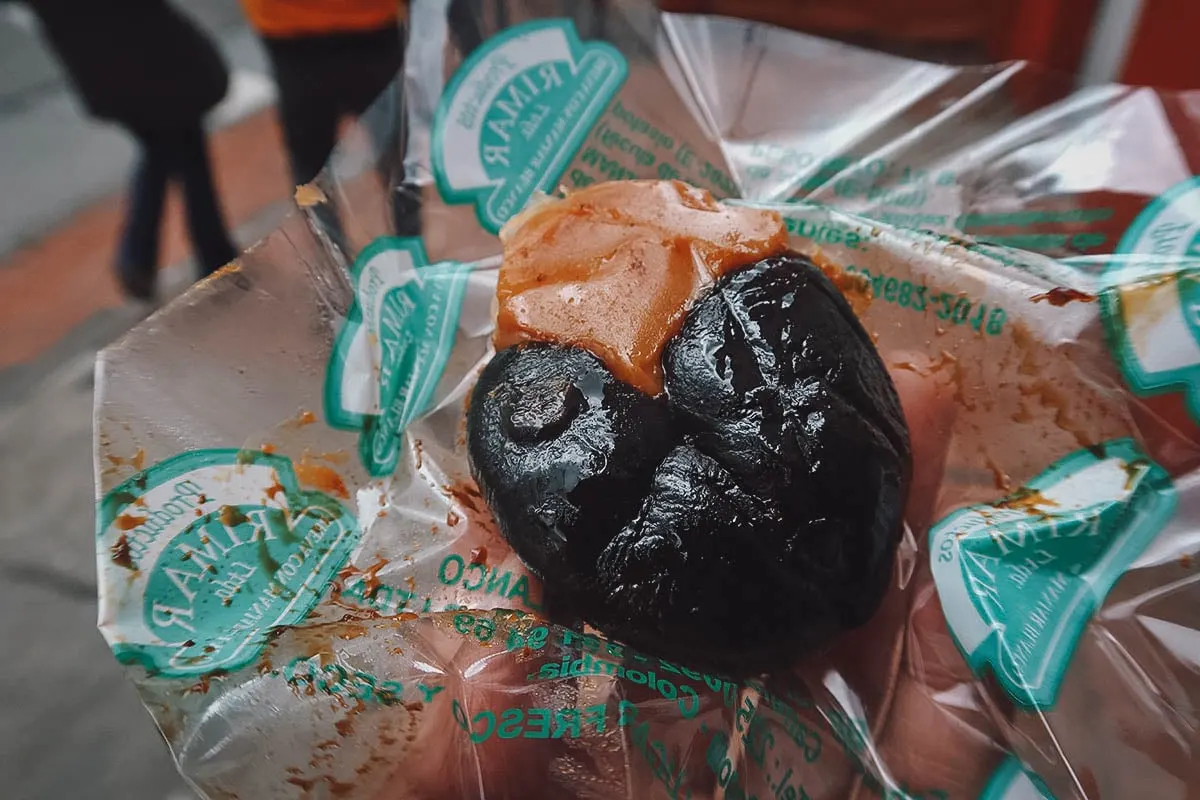
21. Cremas
When I visited Comuna 13 in Medellin, I overheard a guide tell a group of tourists that eating cremas was a tradition when visiting the neighborhood. I’m not one to argue with tradition so I made sure to try this refreshing Colombian dessert before leaving.
Cremas refers to a fruity ice cream popsicle in Colombia. They make them with different types of fruit but I recommend trying the mango biche. It’s drizzled with lime juice and contains chunks of frozen green mango.
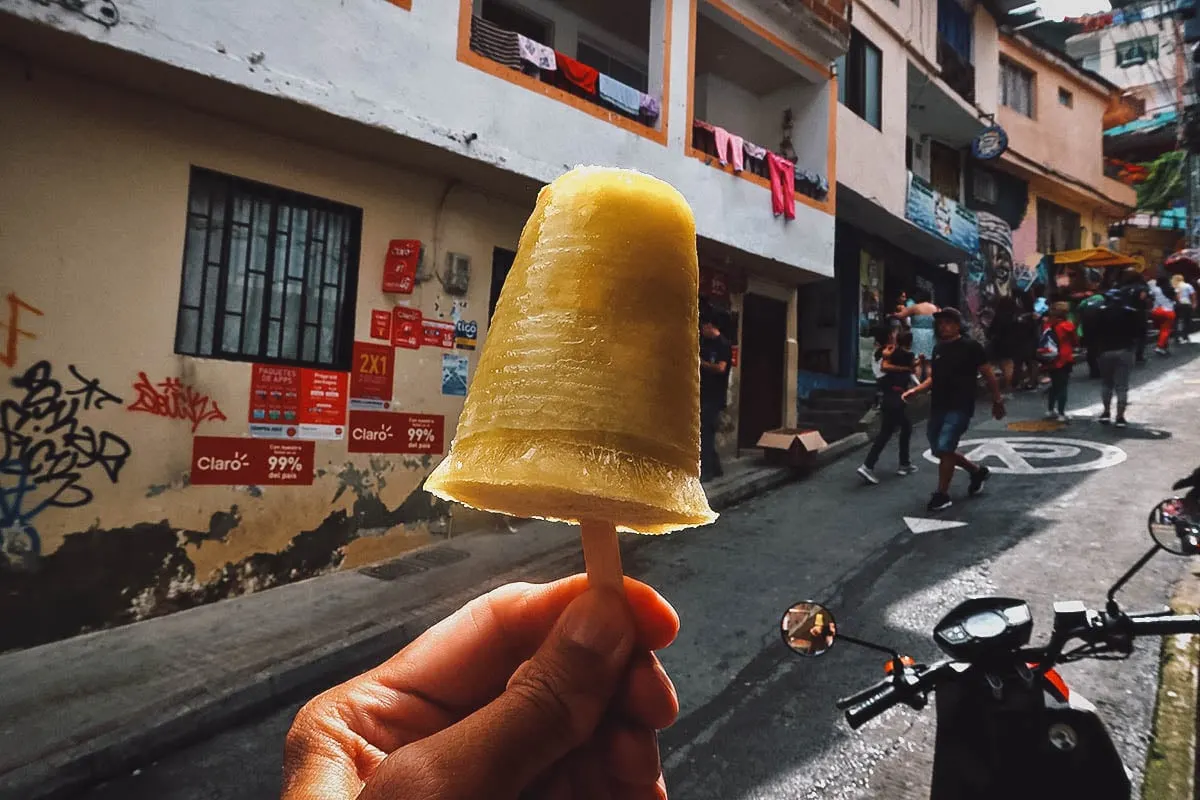
22. Guarapo
Whenever we visit Vietnam, my favorite drink to cool ourselves with is nuoc mia, otherwise known as sugarcane juice.
Freshly pressed sugarcane juice is consumed in many countries around the world like Brazil, Indonesia, Egypt, India, and Pakistan. It goes by many names but in Colombia, it’s known as guarapo.
This incredibly refreshing drink will be a godsend on a hot day in Colombia. Some street stalls will mix in a spritz of lime with the sugarcane juice but in my opinion, it’s best without it.
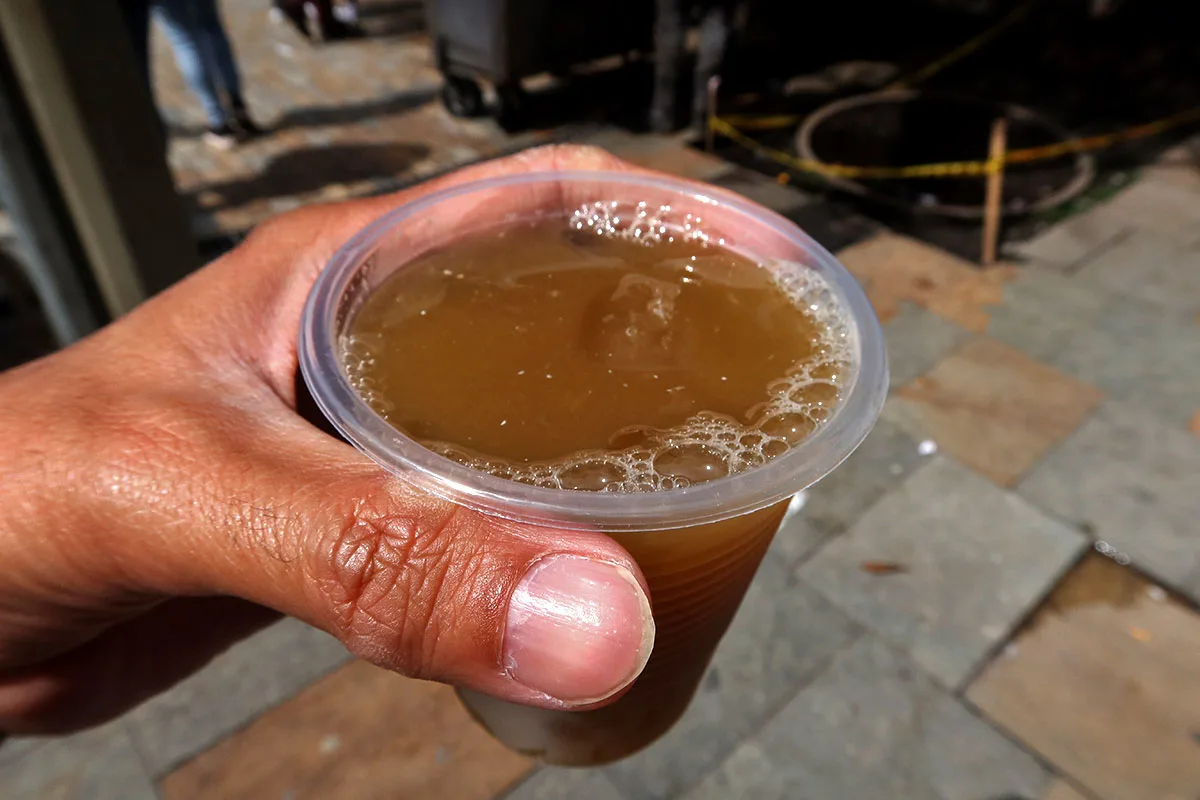
23. Chicha
Like lechona tolimense and brevas con arequipe, we enjoyed this refreshing glass of chicha on our Bogota food tour.
A traditional Andean and Amazonian drink, chicha is commonly consumed in many countries throughout Central and South America. Fermented or non-fermented, it’s traditionally made with corn but it can be produced from other ingredients as well.
In Colombia, chicha is traditionally made with cooked corn and sugar that’s left to ferment for six to eight days. Though it’s made from different ingredients, it reminded me a bit of Mexican pulque.
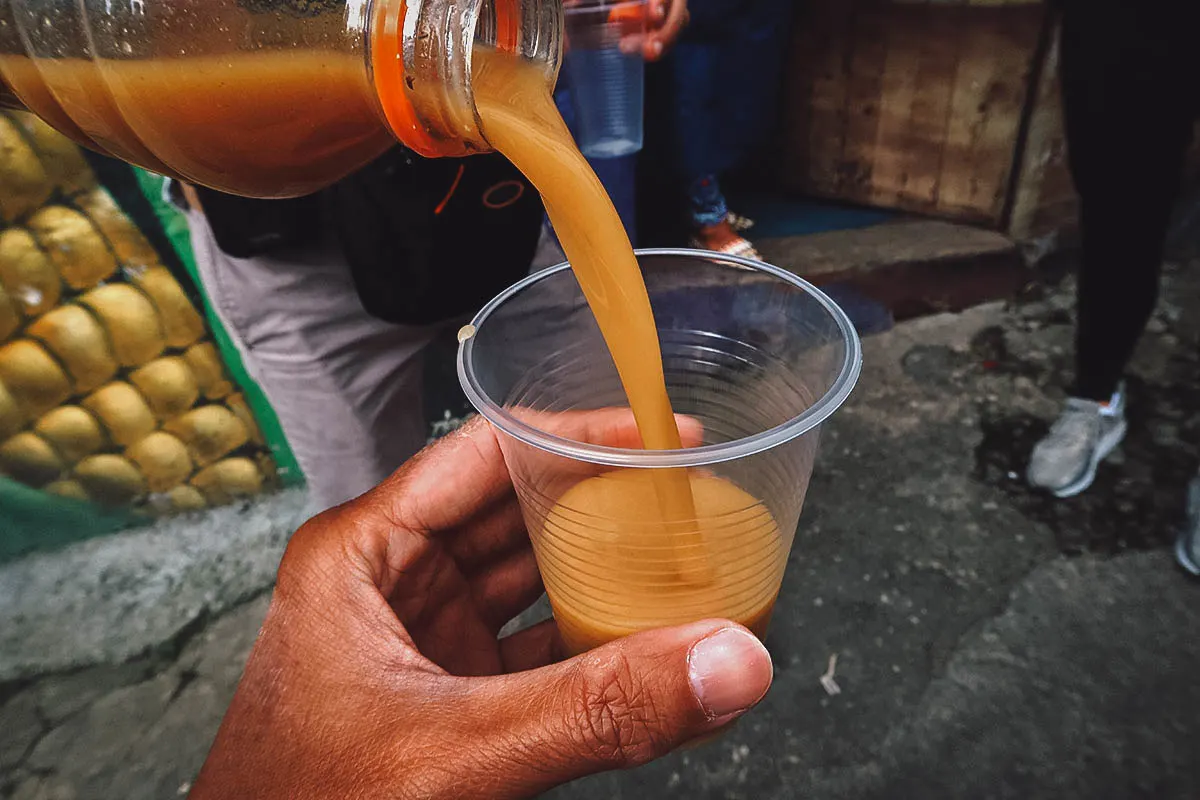
24. Canelazo
This interesting drink warmed us on the cold streets of Bogota. Canelazo is a traditional hot Colombian drink made with agua de panela (panela water), cinnamon, and aguardiente. Aguardiente is an anise-flavored liqueur that’s extremely popular in Colombia.
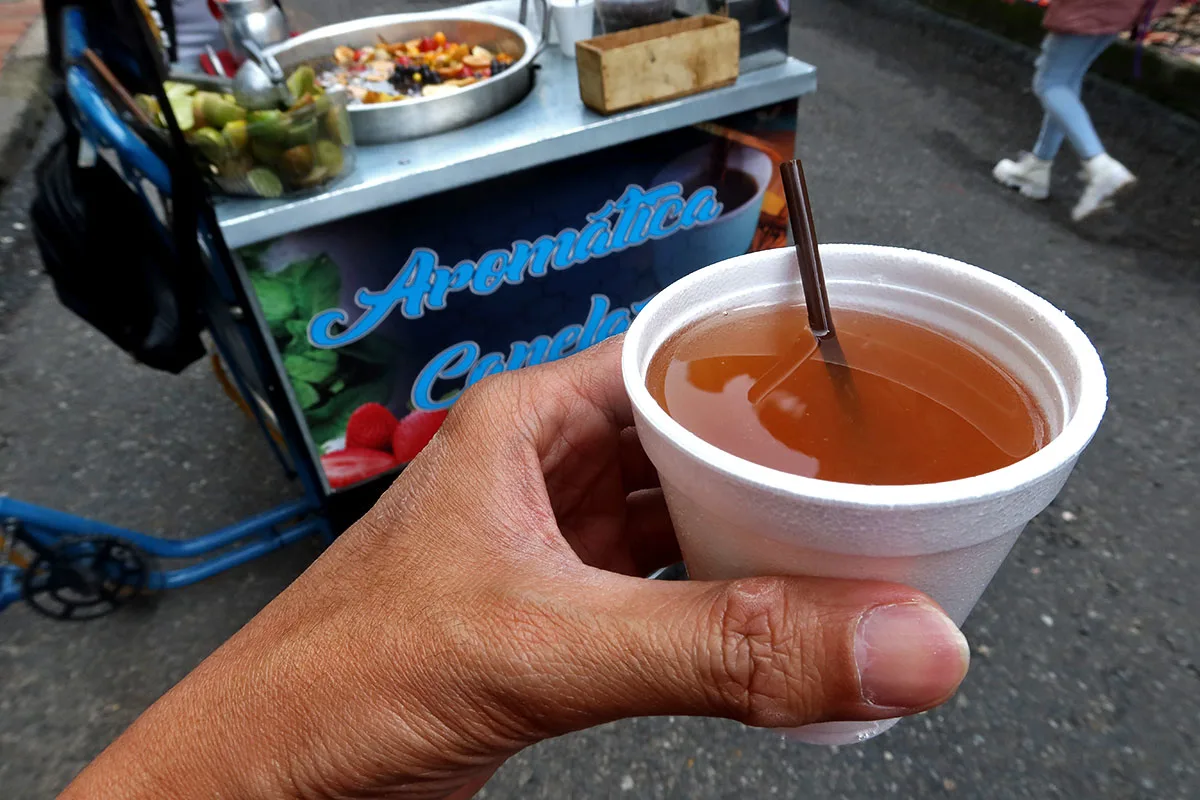
I looked up recipes online and traditional Colombian canelazo appears to be made with just cinnamon, agua de panela, and aguardiente. However, this vendor’s brew contained many different types of fruit and spices as well. She also had different bottles of liquor on hand, so I guess you could choose what type you wanted?
In any case, canelazo is a tasty beverage that’s great to warm yourself up with on a wintry day in Bogota.
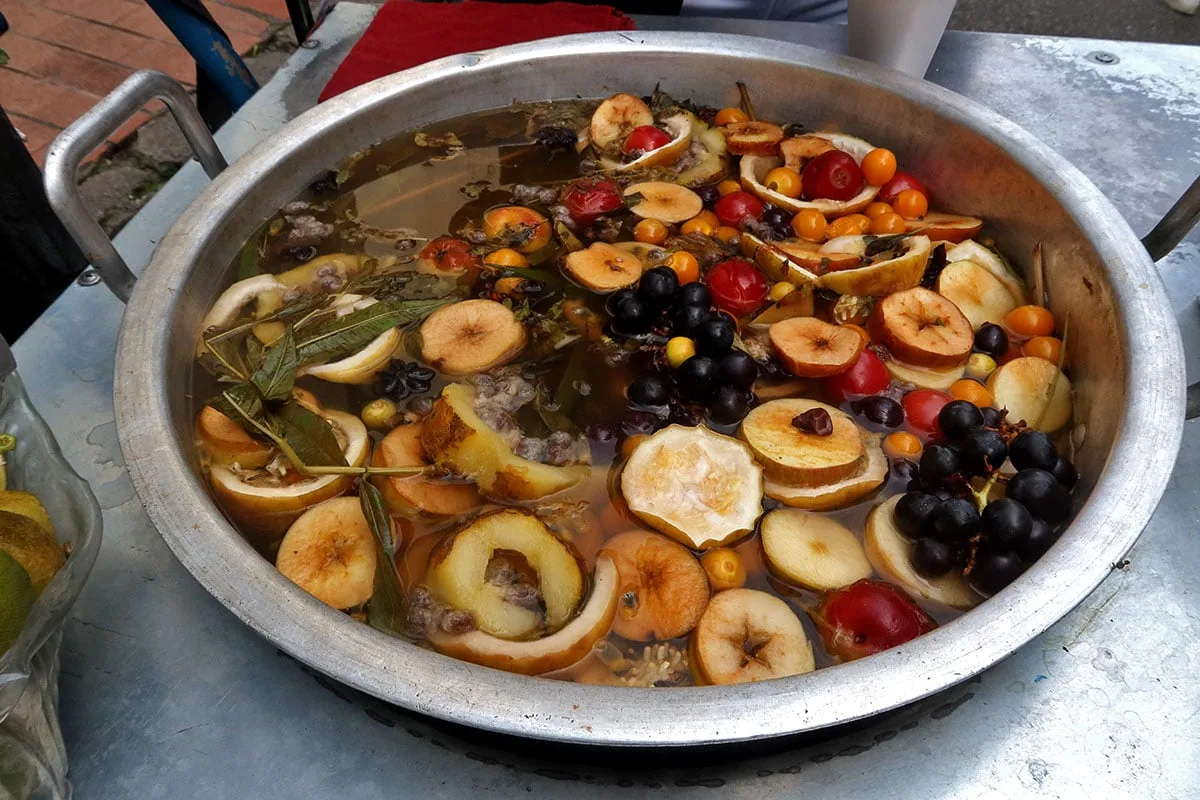
25. Colombian Coffee
Last but certainly not least is this hot beverage that needs little introduction – Colombian coffee. Like you, we’ve heard many stories about the coffee in Colombia and we were pleased to learn that they’re all true.
I’ve been drinking four to five cups a day of strong black coffee for several years now but going to Colombia made me feel like I was discovering it for the very first time. Balanced, caramel-y, and with the right amount of fruitiness and acidity, the coffee is delicious everywhere in Colombia.
From street baristas in Cartagena to artisanal coffee shops in Bogota, I never had a cup of coffee that I didn’t enjoy immensely in Colombia.
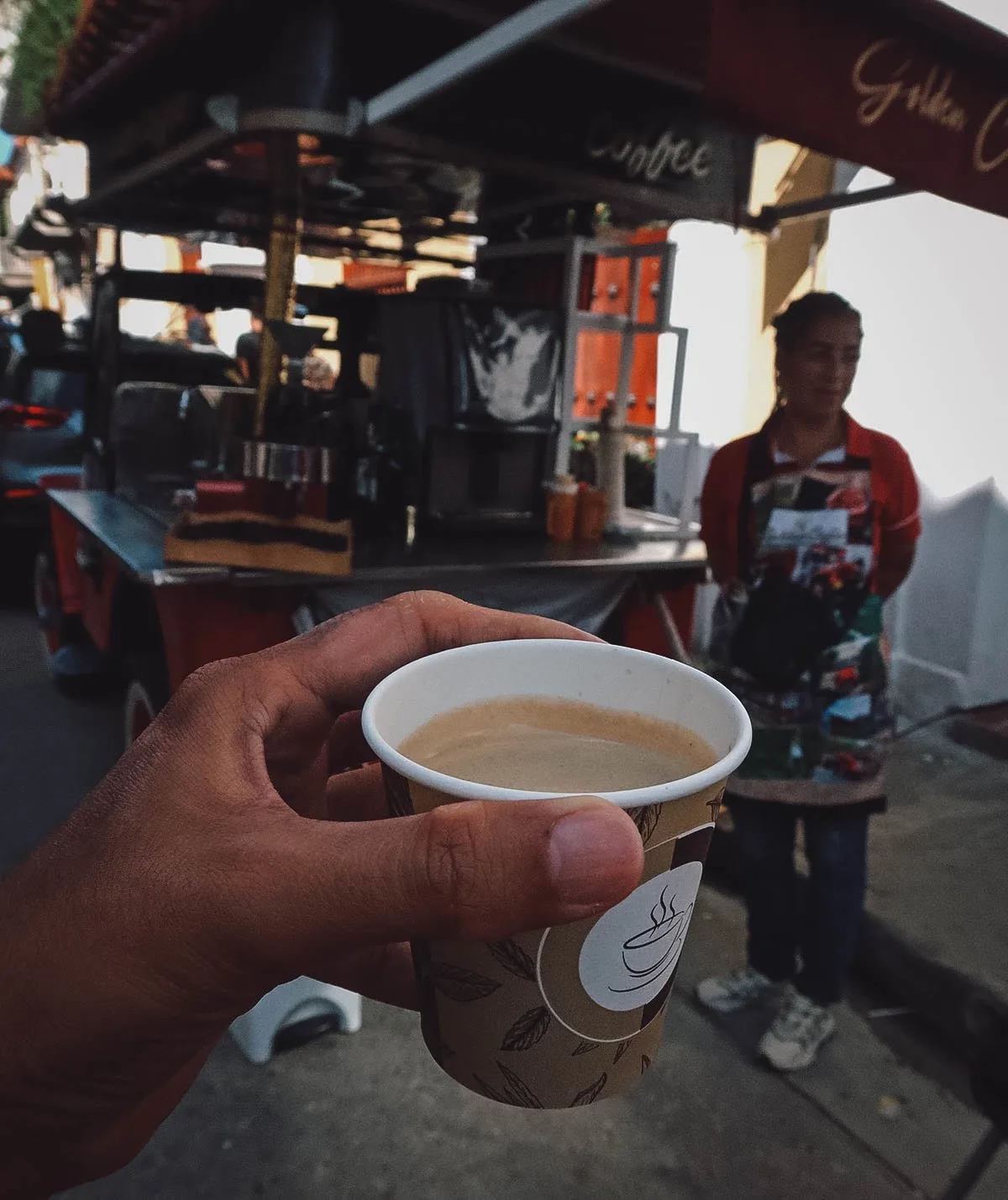
COLOMBIAN FOOD TOURS
In my opinion, there’s no better way to get to know the local cuisine than by going on a food tour. Not only will a knowledgeable local take you to the city’s best restaurants, markets, and street food stalls, but they’ll be able to explain all the dishes to you in more detail as well.
As advised, we went on an excellent street food tour in Bogota. It’s led by Andres, a certified food historian who knows everything there is to know about Colombian food. I highly recommend booking that tour if you’re going to Bogota.
For more food tours in Bogota and in other parts of Colombia, I suggest checking out Get Your Guide.
FINAL THOUGHTS ON COLOMBIAN STREET FOODS
From the mountainous Andean region in central Colombia to the seafood-rich shores of the Colombian coast, you’ll find a wealth of tasty street food dishes in a country that’s long been recognized as one of the world’s most biodiverse. After over a month in Colombia, it was nice to see that diversity carry over to its street food as well.
There’s no doubt in my mind that you’ll love traditional Colombian dishes like bandeja paisa, ajiaco, and cazuela de mariscos. But you’ll enjoy street food dishes like cocteles, arepas de huevo, and bocadillo just as much.
So, are you excited to eat your way through Colombia yet?
Disclosure
Some of the links in this Colombian street food guide are affiliate links. What that means is that we’ll earn a small commission if you make a purchase at no additional cost to you. As always, we only recommend products and services that we use ourselves and firmly believe in. We really appreciate your support as it helps us make more of these free travel and food guides. ¡Muchas gracias!


Kay
Friday 20th of October 2023
Great article. I spend a lot of time in Colombia and adore the street food, so reading through this is such a pleasure! Have you tried the traditional cheesy hot chocolate?! Colombians know how to do food and drink so very right!
JB & Renée
Saturday 21st of October 2023
Chocolate santafereño? Yes love it! Happy to hear you enjoyed the article.
Nichole beer
Wednesday 25th of January 2023
Loved this piece on one of my favorite spots, Colombia. I would however add, Obelas to your list.
JB & Renée
Sunday 5th of February 2023
Happy you appreciated it Nichole! We loved our time in Colombia.